
www.simmental.org
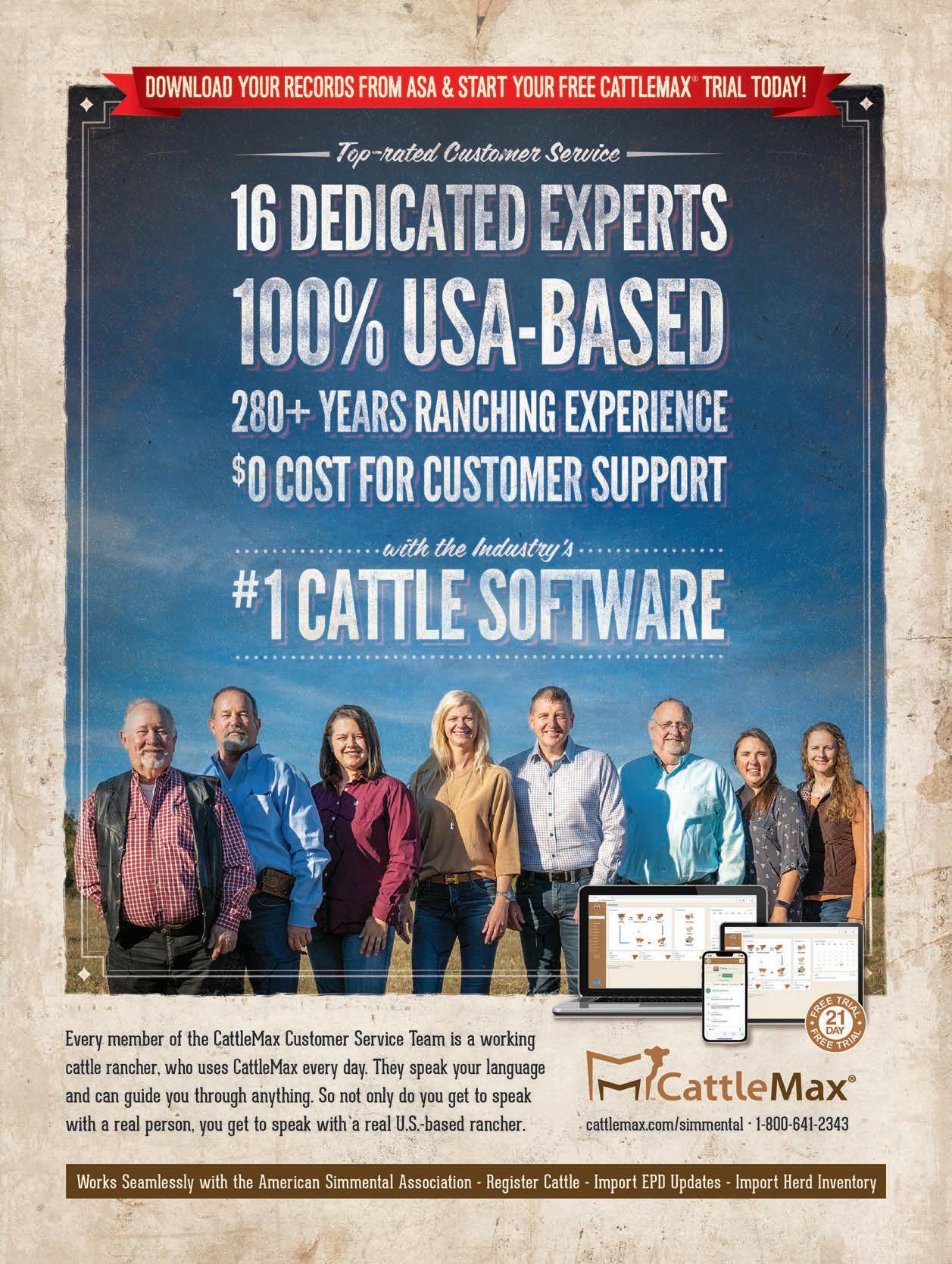

ASA Spotlight
Why Use EPD and Indices to Make Decisions for Bull Sales?
by Chad Russell, University of Nebraska–Lincoln
Until the development of EPD, most bull-purchasing decisions were based on phenotype. EPD predictions better estimate a bull’s potential. The All Purpose Index ($API) and Terminal Index ($TI) combine many EPD into one value.
16
Comparing Breed, Heterosis Effects on Mature Weight
by Dr. Robert Hough
Research on mature cow weight helps producers take advantage of breed differences and complimentarity to make breeding decisions.
20 A Look Back at Fall Focus 2023
 by Callie Cooley, ASA communications coordinator
by Callie Cooley, ASA communications coordinator
Simmental enthusiasts gathered in Denver, Colorado, for tours, a symposium, celebration, and more.

28 STYLE 2023 Focuses on the Future
by Sarah Goss, STYLE 2023 participant
The second annual SimGenetics Training for Young Leaders and Entrepreneurs explored ASA’s unique and flexible model.

30 Sexed Semen: An Opportunity to Capture More Value for Cattle

 by Wyatt Bechtel, Filament Ag
by Wyatt Bechtel, Filament Ag
As markets fluctuate, breeding for either heifers or steers can help you meet demand.
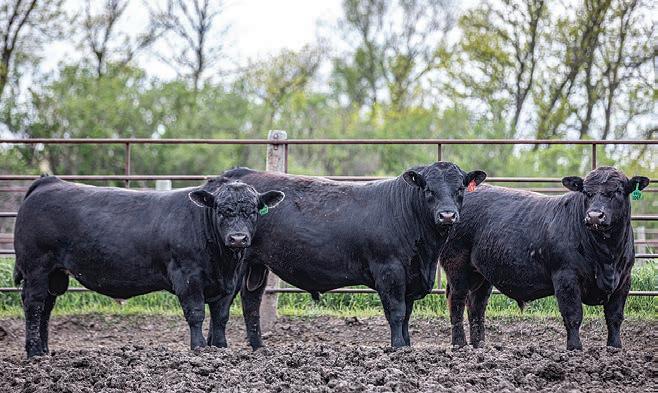

16 2 Register / October 2023 CONTENTS the Register u October 2023 u Volume 37, Number 2
20
28 12
30

© SimGenetics
© Simple trait selection



© Genetic
tools
© Frequently asked questions



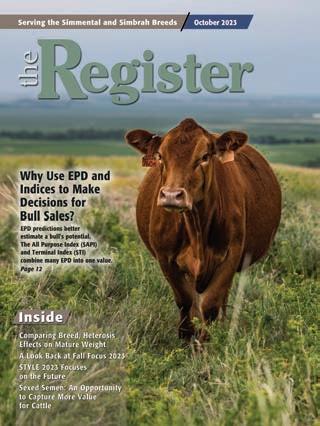

the Register (Issn: 0899–3572)is the official publication of the American Simmental Association, published monthly, except bimonthly, in December/January, May/June, and July/August by ASA Publication, Inc., One Genetics Way, Bozeman, Montana 59718, and is a wholly owned, for-profit subsidiary of the American Simmental Association. Periodicals Postage paid at Bozeman, MT, and at additional mailing offices. Subscription Rates: $50 (US), $100 (US) First-Class, $150 (US) All International Subscriptions. POSTMASTER: Send address changes to the Register, One Genetics Way, Bozeman, Montana 59718. Printed in USA CONTENTS the Register u October 2023 u Volume 37, Number 2 About the Cover Northern SimGenetics breeders are taking advantage of fall pasture before winter arrives. Photo taken by the Grant Company at Stavick Simmental in Veblen, South Dakota. ASA Voices 8 Trustee Viewpoint 10 From the Headquarters 34 AJSA Connection Data & DNA 60 ASA Fee Schedule ASA & State Updates 36 Fleckvieh Forum 40 Bulletins 58 New Members American SimmentalSimbrah Foundation 38 Foundation Focus Industry Insight 41 Corporate Report 42 Beef Business 46 International 48 Cutting Edge Sales & Shows 62 Date Book Cattle Trivia 50 Cow Sense The Fine Print 64 Rates & Policies 66 Advertiser Index 4 Register / October 2023 Member of C H E C K U S O UT O N LI N E www.simmental.org
you visited simmental.org lately?
entire website has a new look highlighting
Have
The
cattle sales, industry events, ASA’s programs, marketing opportunities, and breeders’ resources. simmental.org
makes it easy for you. Breeders’ resources include information on:
improvement

Stanley Martins MAJOR HERD REDUCTION SALE
Saturday, November 18, 2023, Decorah, Iowa
z Four sons of Ms Moses sired by South Seven Adonis averaged $24,750.
z Five daughters have averaged over $10,000.
z At least four other daughters have been donor cows in major herds.
z Ms Moses gave us 15 female sexed embryos on her last flush in August of 2023.
z Ms Moses will be one of the many featured cows in our Major Herd Reduction Sale!
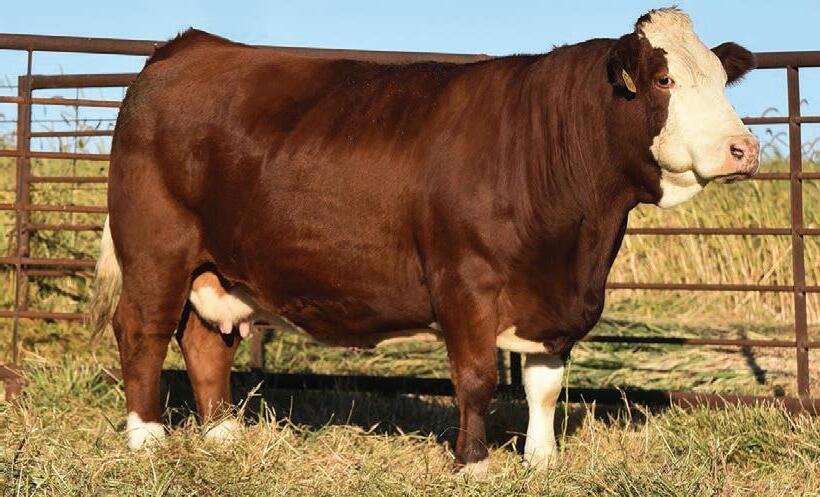
STANLEY MARTINS FARMS
thepublished by
ASA Publication, Inc.
One Genetics Way, Bozeman, Montana 59718 USA
406-587-2778 � fax: 406-587-9301
www.simmental.org � email: register@simmgene.com
Canada Publications Agreement Number: 1875183


ASA Publication, Inc., Board of Trustees
Chris Ivie, Chairman � Tim Clark, Vice Chairman
Doug Parke � Chad Cook � Ryan Thorson
Wade Shafer, PhD, Executive Secretary-Treasurer
CEO Business Manager
Wade Shafer, PhD Chip Kemp
141 Hwy 18 • Postville, IA 52162 563-419-2444 (c) • 563-864-7305 (h) stanmartins1234@gmail.com www.stanleymartinsfarms.com
ASA Board of Trustees
Executive Committee
• We sell bulls every month of the year.
• 90% of our bulls sell from $3,000-5,000.
• We export.
Doug Parke, Chairman � Chris Ivie, Vice Chairman � Chad Cook, Treasurer
Tim Clark � Ryan Thorson � Wade Shafer, PhD, Executive Vice President
Barry Wesner, Immediate Past Chairman
North Central Region
Tim Clark (2024) 1999 18th St NW Turtle Lake, ND 58575 � 701.799.7752 Tim.Clark@hubbardfeeds.com
Loren Trauernicht (2025) 901 E Pine Rd Wymore, NE 68466 � 402.230.0812 mtrauernicht@diodecom.net
Matt Aggen (2026) 27133 146th St Harmony, MN 55939 � 701.866.3544 mattaggen@hotmail.com
Troy Marple (2026) 9450 Michaels Rd Westmoreland, KS 66549 � 785.250.0522 troy.j.marple@gmail.com
Eastern Region
Western Region
Chad Cook (2024) PO Box 174 Walsh, CO 81090 � 719.529.0564 bridlebitsimm@gmail.com
Maureen Mai (2025) 427 Peaceful Way Bonners Ferry, ID 83805 � 208.660.2726 rymocattle@gmail.com
Ryan Thorson (2025) 1725 Road 261 Glendive, MT 59330 � 406.694.3722 ryanthorson7@gmail.com
Quin LaFollette (2026) 1476 Hwy 14A Powell, WY 82435 � 307.899.3553 Quin@Blacksummitcattle.com
Managing Editor Advertising/Editorial Coordinator

Lilly Platts Rebecca Price
Sales Manager Media/Website Administrator

Nancy Chesterfield Kathy Shafer
Design/Production
Joel Coleman
Gretchen Jensen
Jenna Wacker
American Simmental Association
One Genetics Way, Bozeman, Montana 59718 USA 406-587-4531 � fax: 406-587-9301
www.simmental.org � email: simmental@simmgene.com
Chris Ivie (2024) PO Box 264 Summertown, TN 38483 � 931.215.0316 iviejc@usit.net
Doug Parke (2024) 153 Bourbon Hills Dr Paris, KY 40361 � 859.421.6100 office@dpsalesllc.com
Barry Wesner (2024) 1821 W 700 S Chalmers IN 47929 � 219.863.4744 wesnerlivestock@yahoo.com
Brandi Karisch (2026) 648 Polly Bell Rd Starkville, MS 39759 � 225.717.3324 mbkcattle@gmail.com
Scott Trennepohl (2026) 6591 W 625 N Middletown, IN 47356 � 765.620.1700 sttrennepohl@yahoo.com
South Central Region: Brandon Callis (2024) 26123 State Hwy 152 Minco, OK 73059 � 979.204.1265 callissteer@yahoo.com
Victor Guerra (2024) PO Box 92 Linn, TX 78563 � 956.607.5515 vgg03@aol.com
Joseph Hensgens (2025) 136 Deer Park Ln Rayne, LA 70578 � 985.992.9119 joehensgens@yahoo.com
Greg Burden (2026) 890 VZ CR 2205 Canton, TX 75103 � 405.780.0372 greg.gbcattle@gmail.com
6 Register / October 2023
Kuntz Ms Moses
Saturday, October 28, 2023
1:00 PM – Females Sell First Lunch at 12:00 Noon

At the Ranch, Winona, Texas (10678 FM 757, Winona, Texas 75792)
Selling
70 Simmental and SimAngus™ Bulls
• Yearling to Two-Year-Old Bulls


• All are polled
• Most are AI sired by breed leaders in both Simmental and Angus
50 Simmental and SimAngus™ Females
• Breds and Pairs plus both Simmental and SimAngus™ Open Heifers ready to breed


• All are polled
• Most are AI sired and bred to AI sires

100 Simbrah Females
• Breds, Pairs and 3-N-1’s plus F1 Simbrah Open Heifers ready to breed
• Most are ½ Simmental ½ Brahman heifers resulting from the mating of productive 7P Ranch Simmental cows to ONE elite Brahman AI sire – Mr Kallion 1352



• The disposition is Excellent on these cattle
• Most are registered with the American Simmental Association and also eligible to be Golden Certified registered with the American Brahman Breeders Association
Simmental and SimAngus™ Bulls
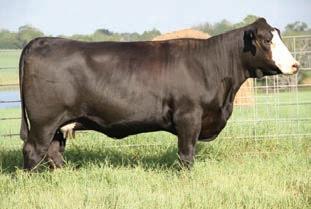
Auctioneer:
Mark Tillman • 210-216-6754 • TX LIC# 9642
Sale Consultants:





Warren Garrett • 903-316-2889
Marty Ropp • 406-581-7835
Simmental and SimAngus™
Simbrah Females Like us on Facebook. www.7PRanch.com Call us today for your catalog
Females
Go to www.CattleInMotion.com to view online catalog and videos of our sale offering AND for live broadcast with internet bidding available on sale day.
by Troy Marple, North Central Region

Hopefully this viewpoint finds you, your family, and your ranches doing well. I know I personally look forward to this time of year when we transition from summer grazing season into fall. With the season change comes weaning the spring calves, and fall calving is underway; this may be my favorite time of year. As I write this, I am traveling home from the annual Fall Focus and our August board meetings, held in Denver, Colorado. A big shout out to the Colorado Simmental Association for hosting and the ASA staff for organizing an amazing program. Those of you who were able to attend can fully understand what an undertaking this event is, and for those of you who were not there or maybe haven’t come to one yet, I would encourage you to look at future Fall Focus events. Breeders come together from all over the country with one common goal in mind — to keep moving our breed and our beef industry forward. Next year’s event will be held in Amarillo, Texas.
In early July the ASA and AJSA concluded the largest National Classic to date in Des Moines, Iowa, in terms of both Simmental cattle and Simmental youth. This was somewhat bittersweet for my family as my daughter aged out this year and this was our final National Classic, but we will never lose all the memories. Again, I’m hopeful you were able to attend but if not,
I would once again encourage you to try and attend it as you will not only see some tremendous Simmental genetics but some even better young Simmental enthusiasts. Next year’s event is in Tulsa, Oklahoma.

In mid-June ASA staff wrapped up the second SimGenetic Training for Young Leaders and Entrepreneurs (STYLE) event. It is a new leadership program that has been held in Oklahoma City and is designed to develop leaders in our industry. I personally know multiple individuals who have attended this event and it is getting rave reviews. Much like Fall Focus and the National Classic, if you qualify to participate I encourage you to do so. STYLE is designed to educate and mold our next generation of producers.
These are just a few of the major things going on in our breed recently. As I look back at the first half of 2023, we have seen strong demand for SimGenetics at almost every level of the industry and the second half looks to be even more promising. I personally believe our breed is positioned nicely for the coming years in terms of what SimGenetics can offer to the beef industry. We have our predecessors on the Board of Trustees and an amazing staff at ASA to thank for this. However, I know myself and my fellow colleagues on the current Board understand that we cannot rest on our laurels, and that there is a tremendous amount of work still to be done to keep us positioned in the forefront of the beef industry.
In closing I believe we are heading into very exciting times as demand for SimGenetics is trending in the right direction and is in strong demand. It is truly an honor to represent each one of you. I wish you and your ranches nothing but continued success. If I can do anything for you, feel free to reach out as I have an open door and open ear policy. I cannot always promise change, but I can promise your voice will be heard. So, until next time, may the grass remain green, the creeks keep running strong, and the calves weigh heavy. May you all have a safe and blessed end to summer and an even better end to the year. n
8 Register / October 2023 TRUSTEE VIEWPOINT
Statement of Ownership, Management and Circulation Required by 39 USC 3685 1. Publication title: the Register 2. Publication number: 0899-3572 3. Filing date: Sept. 6, 2023 4. Issue frequency: 9 times annually 5. Number of issues published annually: 9 6. Annual subscription price: $50.00 US, $150.00 Foreign 7. Complete mailing address of office of publication: One Genetics Way, Bozeman, MT 59718 8. Complete mailing address of headquarters or general business office of publisher: One Genetics Way, Bozeman, MT 59718 9. Full names and complete mailing addresses of publisher, editor and managing editor: Publisher: Wade Shafer, One Genetics Way, Bozeman, MT 59718 Managing Editor: Lilly Platts, One Genetics Way, Bozeman, MT 59718 10. Owner: American Simmental Association (a non-profit organization), One Genetics Way, Bozeman, MT 59718 11. Known bondholders, mortgages and other security holders owning or holding one percent or more of total amount of bonds, mortgages or other securities: None 12. Tax Status: Has not changed during preceding 12 months 13. Publication name: the Register 14. Issue date for circulation data below: September 2023 15. Extent and nature Average no. of copies No. copies of of circulation each issue during the single issue published preceding 12 months nearest to filing date. a. Total number of copies (net press run): 8,918 9,862 b. Paid and/or requested circulation: 1) Paid/requested outside-county mail subscriptions stated on Form 3541. (include advertisers’ prior and exchange copies): 23 18 2) Paid in-county subscriptions stated on Form 3541 (include advertisers’ proof copies and exchange copies): 8,789 9,734 3) Sales through dealers and carriers, street vendors and counter sales and other non-USPS paid distribution: 0 0 4) Other classes mailed through the USPS 0 0 c. Total paid and/or requested circulation: [sum of 15b (1), (2), (3) and (4)] 8,812 9,752 d. Free distribution by mail (samples, complimentary and other free): 1) Outside-county as stated on Form 3541 0 0 2) In-county as stated on Form 3541 0 0 3) Other classes mailed through the USPS 0 0 e. Free distribution outside the mail (carriers or other means): 10 10 f. Total free distribution (sum of 15d and 15e): 10 10 g. Total distribution (sum of 15c and 15f): 8,822 9,762 h. Copies not distributed: 96 100 i. Total (sum of 15g and h): 8,918 9,862 j. Percent Paid and/or requested circulation (15c / 15g x 100): 99.88% 99.89% 17. Publication of statement of ownership required: Will be printed in the October 2023 issue of this publication. I certify that the statements made by me above are correct and complete. Lilly Platts, Managing Editor Dated: September 6, 2023

FROM THE HEADQUARTERS
 by Chip Kemp, director, ASA and IGS Commercial and Industry Operations
by Chip Kemp, director, ASA and IGS Commercial and Industry Operations











A mirror and a windshield — both are vital for a productive journey.
Looking in the mirror at the bulk of 2023 causes me to harken back to Fall Focus in Denver. No doubt, those of you who were fortunate enough to attend can remember the demos at the new National Western Stock Show grounds, or the socializing with old friends, or the most powerful lineup of speakers and topics since Focus 2000. Ideally, you left with tangible tools that will directly impact your decision-making going forward and add an enhanced enthusiasm about your responsibilities as stewards of the Simmental mindset.
If you weren’t present, watch for videos in the coming weeks and months that were captured during the educational day. The content from the heart health panel is, and will remain, tremendously valuable as you work to understand and communicate about one of the premier concerns in the modern beef business. Or, listen to one of the most honest and straightforward discussions on the sustainability front that you are going to hear. Like your birth weights or carcass records, this data is hard to capture. These experts came together to inform and empower you and your family. Respect their efforts by using their efforts. Use your own website, social media pages, or sale catalog to highlight the forthcoming videos and articles. Will they provide you with some
marketing opportunities? Likely. But even more, they will empower your customers with facts and knowledge that’ll pay dividends for years to come.
Also stay abreast of the steps and actions from the board meetings. Your elected representatives served you remarkably well during the board meetings following the educational weekend. Reach out to them. They can provide you well-rounded and well-informed perspectives on the topics of the day.
Or even better yet, plan to be at the 2024 Fall Focus in Amarillo, TX. Then you and your family can take it all in firsthand.

I confess, with a little time the Fall Focus recollections that resonate the most for me are a bit more subtle. The selfless service of so many friends, breeders, and coworkers. The humble and charitable on-stage interaction between beef leaders who were willing to “learn in public” as they worked through weighty panel discussions on difficult and pressing industry issues. A CEO’s touching recognition of long-time staffers and friends. The model set forth by your ASA trustees as they tackled and solved challenging issues with maturity, thoughtfulness, and the requisite level of compromise. That is servant leadership. That is co-responsibility and engagement. That is stewardship. That is “Love of Neighbor.” Not purely in some emotive sense, but rather as action that works for the good of the other. As I’ve said before, this is part of the uniqueness of the Simmental way. We commit to sound, credible, unbiased science, but we do that while holding fast to our commitment to core values. It is that balance of science and values that will continue our ability to honor our core constituency: the commercial beef producer. Period. Lose that focus and we lose our purpose.
But, enough looking backward. Let’s put that science and value system to work in your sphere. Out your windshield is what comes next. What will you keep the same as we prepare for the next bull sale season? What must change? What are you going to do about it? Who are you going to rely on for help? May I encourage you to think about these hard questions now. Look over the hood of your pickup. Pick your spot on the horizon. Now drive. n
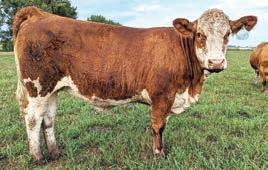
10 Register / October 2023
www.boyleranchfleckvieh.com • boyle_bryan@yahoo.com Be sure to like us on Facebook Bryan and Brittany Boyle 4824 110th Street Washta, IA 51061 712-870-8666 If you want to raise bulls like this… Be sure to attend our Red , White and Beautiful Fleckvieh Female Online Sale, November 2 - 4, 2023; www.auctions.boyleranchfleckvieh.com Boyle
Ranch

Indices and EPD to for
by Chad Russell, PhD student with Dr. Spangler at the University of Nebraska–Lincoln



Until the development of expected progeny differences (EPD), most purchasing decisions of bulls were based on phenotypic measurements and features as an estimate to how that bull’s calves would perform. Phenotypes (P) are the combination of genetics (G) and environment (E); (P = G + E). There are components of genetics that aren’t heritable, such as the unique combination of genes that results in hybrid vigor, or inbreeding suppression. These gene combinations will influence an animal’s own phenotype, but won’t be passed down to their offspring. EPD estimates only the heritable genetic component of that animal. So why would you want to make a purchase decision just on the genetic merit?

For an example, let’s look at the relationship between an animal’s own birth weight and the portion of that phenotype related to their genetic merit for birth weight. If you were to take two bulls whose EPD for birth weight were -1.0 and -4.0 lbs. and you breed your herd to both of these bulls, in a hypothetical situation where the calves have the same environment, the equation P = G. As a result, the second bull’s calves would on average be 3 lbs. lighter at birth, all other factors equal, which may reduce the number of problematic births caused by dystocia.
But that single birth weight you see in the catalog for that bull is influenced by his environment and his unique gene combinations, which aren’t heritable. Was he treated differently than other bulls, or weighed later or as soon as he hit the ground? EPD predictions use his own birth weight record as well as records from his half-sibs, parents, and any relevant genetic information — such as breed, birth year, comparisons to contemporaries, genomics, and pedigree — to better estimate his true potential and prevent over- or underestimation based off of just his own birth weight record.
Similarly, we are able to improve the accuracy of the estimate of his potential by using records from his progeny. However, it takes time for his calves to hit the ground, and a risk is being taken by using him for breeding when
Adding a DNA test to your decision is like knowing...
� 25+ calving ease scores
� 22 birth weights
� 25+ yearling weights
� Stayability/productivity records on 15 daughters
� 6 carcass weights
� 10 marbling scores

� 8 ribeye measurements
All this from a test you can complete before you wean the calf
the accuracy is lower. Enter genomic testing. By identifying markers in his DNA that play major parts in his performance, we can incorporate information that is equivalent to already having~20 calves on the ground. This provides an increase in accuracy that may alleviate some risk from breeding a bull to your cows and not getting what you want. These influences on phenotypes hold true for all heritable traits, which leaves a lot to consider when buying a bull. In order to make it simpler, we have indices such as the All Purpose Index ($API) and Terminal Index ($TI) that take into account many EPD and combine them in one value expressed in dollars of profitability predictions among bulls. These indices estimate profitability when a percentage of daughters remain in the herd as replacements and other calves are terminal ($API), or a strictly terminal system ($TI), depending on what your operation needs to meet its goals.

12 Register / October 2023
Incremental increase in accuracy of an EPD
As more information is known on an animal, the accuracy of the EPD increases. Information includes an animal’s own records; family information, such as parents and siblings and their records; genomics; and eventually progeny. Genomic information for BW adds an equivalent of 22 progeny records. For example, if a bull had a BW EPD of 2.0 lbs. and an accuracy (Acc) value of 0.15., the associated possible change (PC) is ± 2.5 lbs. Therefore, we would expect his “true” BW EPD to be between –0.5 and 4.5 lbs. (2.0 ± 2.5) 68% of the time. If genomics are added, the accuracy might increase to 0.45 and the possible change will drop to 1.7, leaving a range for his “true” BW EPD between 0.3 and 3.7.


Editor’s note: This article originally appeared in the January 2022 issue of SimTalk
Chad Russell grew up on a ranch raising Simmental and SimAngus cattle with his parents, Curtis and Susan Russell. His work on the ranch and love for animals and math, along with discussions with Dr. Wade Shafer, drove him to to study animal genetics. Russell attended Colorado State University where he double majored in animal science and mathematics. He is now at the University of Nebraska–Lincoln, where he completed a master’s degree and is now working on a PhD with Dr. Matt Spangler.

October 2023 / Register 13
This bull sale season, study the numbers to ensure you select the heritable portion of what you see and pay attention to economic indexes to select for profitability of future genetics. n
Best Practices to Receive the Most Accurate Genetic Predictions
Clearly define breeding objectives
With the ability to increase the rate of genetic change comes the possibility to make mistakes at a faster pace. Breeding goals need to be clearly identified to ensure that selection at the nucleus level matches the profit-oriented needs of the commercial industry.
Use whole herd reporting
Inventory-based reporting captures more complete phenotypes on reproduction and longevity traits, and thus creates more accurate genetic selection tools.
3







Properly define contemporary groups
It is important for the precision of the genetic evaluation to group animals treated uniformly. Proper reporting of contemporary groups reduces bias in EPD.
Take data collection and reporting seriously

Phenotypes are the fuel that drives the genetic evaluation. Take pride in collecting accurate data. Report records on the complete contemporary group in order to paint the most accurate picture of the genetics in these cattle. If possible, collect additional phenotypes like mature cow weight, cow body condition score, udder scores, feed intake, and carcass data.
Make both thorough and accurate phenotypic data collection for economically relevant traits a high priority
The quantity and quality of fertility traits need to dramatically improve. Providing disposal codes to identify why females leave the herd is vital. Commercial data resources, where the true economically relevant traits exist, are going to become more critical to capture. Breeders can help prove the genetics of their own seedstock by encouraging their commercial customers to join ASA’s Commercial Total Herd Enrollment (THE) option and add valuable data to the evaluation.
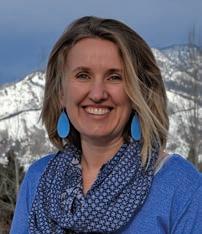
Use index-based selection


As the list of published EPD continues to grow, using economic selection indices will become even more helpful to reduce the complexity of multiple trait selection.
If the number of EPD increase, tools to reduce the complexity of sire selection for commercial producers must continue to develop. Breed associations and seedstock producers have the obligation to aid commercial clientele in making profitable bull selection decisions.
Use genomics

Genomic selection offers an opportunity to increase the rate of genetic change and break the antagonistic relationship between generation interval (the average age of the parents when the next generation is born) and the accuracy of selection (e.g., accuracy of EPD) — two components that determine the rate of genetic change. However, as with any tool, genomic information must be used correctly and to its fullest extent.
Adding a DNA test to your decision is like knowing . . .
u 25+ calving ease scores
u 22 birth weights
u 25+ weaning weights
u 25+ yearling weights
u Stayability/productivity records on 15 daughters



u 6 carcass weights
u 10 marbling scores






u 8 ribeye area measurements
All this from a test you can complete before you wean the calf.
Jackie Atkins, PhD Matt Spangler, PhD
Bob Weaber, PhD Wade Shafer, PhD
1
2
4
5
6
7 14 Register / October 2023
Best Practices for Genomic Testing
All animals within a contemporary group should be genotyped.
If genomic data are meant to truly enable selection decisions, this information must be collected on animals before selection decisions are made. The return on investment of this technology is substantially reduced if it is used after the decision is made. The ASA’s Calf Crop Genomics (CCG) program offers 50% off GGP100K test for breeders who commit to genotype the entire calf crop. See sidebar for more details.
Both male and female animals should be genotyped.
The promise of genomic selection has always suggested the largest impact is for lowly heritable and/or sex limited (e.g., fertility) traits or those that are not routinely collected (e.g.,disease). This is indeed true, but it necessitates that genotyped animals have phenotypes. For sex-limited traits, this becomes a critical choke point, given that historically the vast the vast majority of genotyped cattle are males. If producers wish to have genomic-enhanced EPD for traits such as calving ease maternal and heifer pregnancy, they must begin or continue to genotype females. The ASA has a unique program called the Cow Herd DNA Roundup (CHR) to help herds collect female genotypes. See sidebar for more details.
Total Herd Enrollment (THE)



A cow inventory reporting program, THE requires participants to provide annual reproductive and inventory status on their cow herd. THE is designed to improve quality of data submitted for the genetic evaluation, and in turn improve and develop reproductive EPD. By submitting data on the entire calf crop or contemporary group, breeders will receive more accurate predictions of their cattle. The ASA has four THE options to fit most seedstock and commercial operations.
Cow Herd DNA Roundup (CHR)
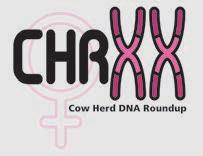
The Cow Herd DNA Roundup (CHR) is designed to increase the number of female genotypes to better predict maternal traits, such as maternal calving ease. Genotyping entire herds reduces bias created when only the best cattle are genotyped. Gathering massive amounts of genotypes on entire cow herds will significantly improve the genomic predictions and rate of genetic progress. As parentage testing is included, CHR herds will have pedigrees validated through DNA. Participating breeders benefit from having genomically enhanced EPD on the entire cow herd — equivalent to a lifetime number of calf records in several traits for an exceptionally low cost.
Calf Crop Genomics (CCG)

Calf Crop Genomics, a research project launched by the ASA in collaboration with Neogen Genomics, offers 50% off GGP100K genomic test including parentage ($25 compared to $50 equivalent test) to participating breeders who test their entire calf crop. Genotyping entire calf crops is important to use genomically enhanced EPD (GE-EPD) for selection decisions, reduce selection bias in genomic predictions, and increase the volume of genotyped animals for future improvements to genetic predictions. The latter two points make any singular genomic test in the future better for all members using genomics.
of additive genetic merit.




Do not forget the value in correcting parentage errors, tracking inbreeding levels, identifying unfavorable haplotypes, estimating breed composition, and estimating retained heterozygosity. All of these can be garnered from populations that have a well-defi ned set of genotyping protocols.
The beef industry should be congratulated for the rapid adoption of genomic technology, but there is a lot of work to do. Of critical importance is the fact that genomic technology will continue to change and does not replace the need for phenotypes nor the fundamental understanding of traditional selection principles including EPD and accuracy.
Carcass Expansion Project (CXP)
Despite the importance of carcass traits to our industry, few producers devote resources to collecting and recording actual carcass data. While the Carcass Merit Program (CMP) is a valuable progeny test, it is limited in the number of records produced. We cannot depend on the CMP alone to bring in carcass data. In the age of genomics, it is clear we need genotypes on animals with actual carcass phenotypes. Adding another layer of commitment to predicting carcass traits, the ASA initiated a new program, called the Carcass Expansion Project, in the fall of 2018 to increase the number of carcass records on genotyped animals. The ASA is are ramping up both phenotypic and genotypic data collection on terminal calves — a vital part of our vision.

1
2
Genotypes can provide useful information in addition to predictions
3
October 2023 / Register 15
Breed, Heterosis

 by Dr. Robert Hough
by Dr. Robert Hough
In a recent issue of the Journal of Animal Science, the scientists at the University of Nebraska and US Meat Animal Research Center (USMARC) published their findings on the mature weight differences of the 16 breeds in the current USMARC Germplasm Evaluation Program (GEP).
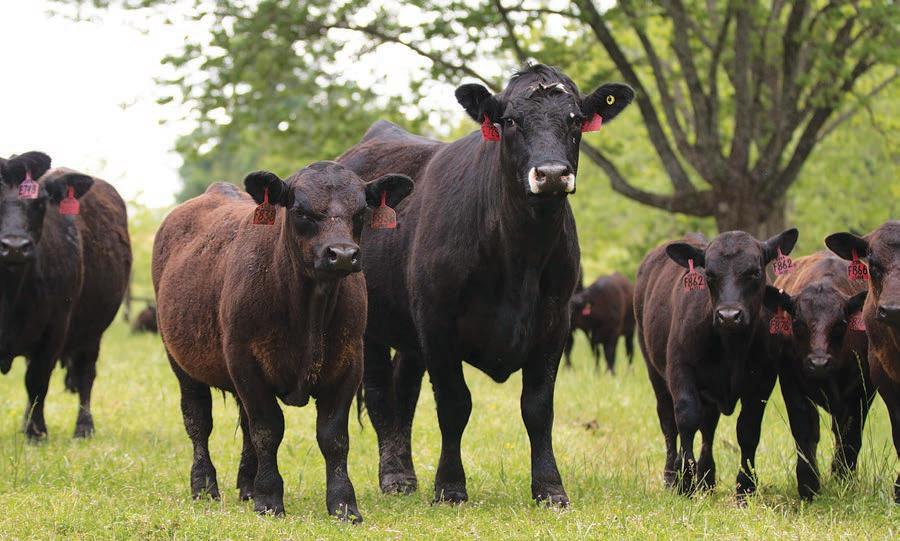
The article, “Breed and Heterotic Effects for Mature Weight in Beef Cattle,” is found in Volume 99, Issue 7 of the July 2021 Journal of Animal Science
As usual, the results of their analysis demonstrate breed differences — although in this case, a single trait — which help producers design breeding programs that account for and take advantage of these breed differences and complementarity.
The USMARC, part of USDA’s Agricultural Research Service, is located in Clay Center, Nebraska, on what was a 34,000-acre decommissioned US Navy munitions depot. Starting with the 1970 calf crop, the Germplasm Evaluation Program has been our country’s — and for that matter, the world’s — most comprehensive comparison characterizing breeds for various biological properties.
Whereas in the early years the GEP was run in cycles, they have recently gone to a continuous approach of studying our country’s most economically important breeds. This has presented some unique statistical challenges, one of which is accounting for sampling bias in
the sires they use. In this case, they adjusted for selection bias using the sire’s yearling weight EPD compared to the average of the various breeds’ industry population.
In terms of the data used in the mature weight comparisons, the study involved 5,156 cows with 108,957 weight records collected throughout the animals’ lifetime, up to six years of age. Most cows had three records per year, which included the third trimester prior to calving, prior to breeding, and when palpated for pregnancy.
A number of statistical models were fit to determine what best explained the breed differences found within the cows in the germplasm study, which had varying breed percentages and repeated weight measures taken over their lifespans.
This alone resulted in a stand-alone peer-reviewed journal article comparing these statistical methodologies: “Comparison of Different Functions to Describe Growth from Weaning to Maturity in Crossbred Beef Cattle.” The article can be found in Volume 97, Issue 4 of the April 2019 Journal of Animal Science.
16 Register / October 2023
Direct breed Industry USMARC Direct breed solution for average average effect for MWT2 (1) YWT EPD3 (2)
YWT EPD (3) MWT2 (4)
1 Solutions are deviations from Angus. The YWT EPD were extracted from genetic evaluations conducted in 2019.
2 Estimate of MWT differences at 6 yrs of age.
3 Average of 2017-born animals.
4 (4) = (1) + 2 x b [(2) - (3)], where b = 0.868 ± 0.999 lb./lb. is the regression of MWT phenotype at USMARC on sire’s YWT EPD from breed association genetic evaluation from 2019.
The average weight of the age-adjusted cows was 1,430 pounds, and the direct heterosis was determined to be 2.4 percent. We generally look at heterosis as a “free lunch,” and in most cases it is, but heterotic effects like increased mature weight and increased milk come at a cost that needs to be considered. The authors’ estimate of heritability of mature weight from these data was 0.56, indicating this is a trait that will respond rapidly to selection.
When viewing the results found in Table 3, Angus, representing the country’s most populous breed, is used as the base upon which other breeds are deviated. This is usual with USMARC germplasm reports.
Column 1 in the table represents the direct mature weight breed solutions, which demonstrates considerable breed variation. For example, Charolais is slightly heavier at 10.6 pounds, compared to Braunvieh at the other extreme at -248.4 pounds.
The direct breed effect estimates seen in column 1 were then adjusted to account for the sire sampling utilizing yearling weight EPD. Yearling weight genetic predictions were chosen because they are based on a commonly reported weight trait most closely associated with mature weight.
Any sire sampling bias was accounted for through regression analysis, which included the average of each breed’s 2017 calf crop’s yearling weight EPD (column 2), and the weighted average of the sires’ yearling weight EPD (column 3) used to produce the USMARC population from which the data was collected. This methodology would also account for bias based on when sires were sampled and the genetic trend differences between breeds.
For example, little difference would be expected in sires sampled over time from a breed with a flat genetic trend. However, because Angus exhibited a particularly steep genetic trend, it resulted in the higher magnitude difference in the averages seen in columns 2 and 3. These breed differences made the researchers’ decision to adjust for sampling bias appropriate and necessary for the mature weight comparisons to be valid.
When this adjustment is made (column 4), the breed differences are magnified. Angus are clearly the heaviest cows in this population, with the next closest breeds being Charolais and Hereford at -19.6 and -38.5 pounds, respectively. Others examples of high-use breeds were Red Angus (-98.6 lbs.), Gelbvieh (-145.4 lbs.), Limousin (-95.3 lbs.), Shorthorn (-132.4 lbs.), and Simmental
(Continued on page 18)
October 2023 / Register 17
Table 3: Direct breed solutions for MWT (lb.), average EPD for YWT (lb.), and adjusted breed effects for MWT for 16 breeds evaluated in the GPE program at the USMARC1
Breed Est. Est. Est. Est. Angus 0.0 95.7 60.1 0.0 Red Angus -47.1 89.1 82.9 -98.6 Beefmaster -84.3 41.1 44.0 -151.4 Brahman -5.5 28.8 17.2 -47.1 Brangus -59.0 49.5 42.0 -108.2 Braunvieh -248.4 74.6 69.1 -300.7 Charolais 10.6 53.9 35.4 -19.6 Chiangus -56.5 70.0 70.6 -119.9 Gelbvieh -112.9 89.8 72.8 -145.4 Hereford 8.4 80.7 71.9 -38.5 Limousin -70.8 94.8 73.0 -95.3 Maine Anjou -20.7 56.8 55.9 -81.2 Salers -18.5 82.7 67.8 -54.6 Santa Gertrudis -4.0 9.0 9.5 -66.7 Shorthorn -74.1 75.9 73.7 -132.4 Simmental -32.6 100.8 88.7 -73.5
Comparing Breed, Heterosis Effects Mature Weight
(Continued from page 17)
(-73.5 lbs.). The most extreme breed difference seen was Braunvieh at -300.7 pounds lower than Angus. There are considerable differences between the breeds as represented in their deviations that could be exploited in a breeding program. When viewed alone, mature weight represents a cost to an operation in the form of maintenance requirements, and, to a lesser extent, potential revenue in the form of salvage value. However, no single trait should ever be considered in a vacuum.
When evaluating breeding decisions — beyond these mature weight estimates — the corresponding revenue potential for things such as the genetic potential for growth and carcass weight must be considered, as well as the ability of an animal to express this potential based on the environment in which it will be asked to perform.
Ultimately, all breeders’ operations are unique systems, and every producer, whether they are separated by region of the country or just a strand of barbed wire, must operate within their unique matrix of environment, feed resources, management, and market. There is no overarching ideal breed or animal, and mature cow size is not a proxy for efficiency, as biologically efficient and inefficient cows come in all sizes.
Therefore, the USMARC scientists, aided by researchers at the University of Nebraska, continue to provide our



Editor’s note: This article was originally published in Western Livestock Journal, and also appeared in the Late Fall 2021 issue of SimTalk.
Dr. Robert Hough has been responsible for recording the story of several breeds through his work as an author. In 2018, he authored Simmental’s American Journey , which documents the breed’s path to the United States, and lays out the events that led the Association to its current place in the industry. He is also a beef industry professional, holding a PhD in animal science from Virginia Tech. Hough has worked in Extension, as the CEO for Red Angus of America, traveled across the world evaluating cattle, and has authored hundreds of industry-focused articles for a variety of publications.

industry with the great service of the Germplasm Evaluation Program. These across-breed comparisons are necessary to build across-breed EPD, indexes, and decision-support software, which will allow producers to make better breeding decisions with each passing year. n Scan
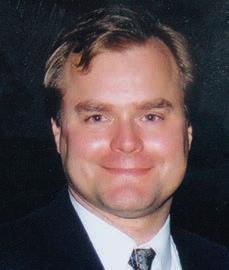
learn how
18 Register / October 2023
this QR code to
Larry Becker uses genetic selection tools and carcass data to make continued improvement to his herd.
To learm more about the CMP visit www.simmental.org, then click Carcass Merit Program under the Commercial tab.
Questions, contact cmp@simmgene.com for more information regarding this program.
ASA#
CMP

The American Simmental Association Carcass Merit Program (CMP) is the beef industry’s most demanding and informative young sire test. The program is a hallmark of ASA breed improvement for economically relevant carcass traits. Commercial producers play an integral part in this project.


Participants receive:
u $200 for each AI-sired calf with carcass information
u Free semen on top young herdsires
u Free ASA Genetic Evaluation on your cow herd
u Free genotyping on terminal progeny

u Keep any or all replacement females
Become a Carcass Merit Program test herd today
*The CMP is a structured young sire progeny test. Participating cooperator herds will random sample their cow herd with CMP semen, and the resulting male (or female) progeny will be harvested with individual carcass data gathered. ASA Staff will work with cooperator herds to provide bulls that fit the general criteria of your management program; however, only bulls nominated into the CMP program may be used. Producers are encouraged to be somewhat proficient in Microsoft Excel for accurate and consistent record-keeping.
CLRS King James 616K
4031931
Class of 2023
Fall Focus at A

 by Callie Cooley, communications coordinator
by Callie Cooley, communications coordinator
Fall Focus 2023 took us to the Centennial State. Simmental enthusiasts, representing 28 states and three provinces, attended the successful gathering that was held in Denver, Colorado, August 25–29. The event featured a “Ranch Gathering,” live cattle demonstrations, a day-long educational symposium, a celebration of the Golden Book and Lifetime Promoter recipients, interactive committee meetings, and a productive board meeting. The Colorado Simmental Association (CSA) co-hosted the event and did a phenomenal job showcasing topics that not only provided a snapshot of issues important to Colorado’s beef industry, but that were arguably just as important to everyone else in attendance. A huge thank you to everyone with the CSA for their help organizing and hosting.
Friday morning began with Simbrah committee, SimSpecialist, and ASA Publication board meetings. The SimSpecialists in attendance strategized, with some of the more experienced specialists offering insight into what has worked well for them in the past. This team is unlike any other in the industry. Giving presentations at field days or answering questions at sales is no big deal to these individuals, many of whom are retired Extension professionals and researchers.
The CSA’s hard work shined brightly at the Ranch Gathering that they co-hosted with the Colorado Cattlemen’s Association (CCA) on Friday afternoon. The event was held at the National Western’s HW Hutchison Family Stockyards Event Center. If you haven’t been to the grounds since they’ve been updated, it’s worth the trip. At the event center, cattle were on display from Bridle Bit Simmentals,
Hill Brothers Livestock, and Reflected R Ranch. Willie Altenberg, Jake Owen, and Ben Elliot also brought cattle for the demonstrations — a special thank you goes out to those individuals for bringing cattle in from miles away. A feet and leg scoring demonstration was given by ASA Geneticist Lane Giess, and a pulmonary arterial pressure (PAP) test demonstration was performed by Dr. Tim Holt, DVM, of Colorado State University (CSU). The welcome rain shower deterred most from visiting the CSU Spur campus; however, the impressive nature of the campus was evident by even the craftsmanship of the Vida, Terra, and Hydro buildings. The evening concluded with a tritip dinner prepared by several CCA members and surprise recognition of Susan Russell, who was given a custommade brand necklace in honor of her 25th year as the CSA secretary/treasurer. Congratulations, Susan.

20 Register / October 2023
(Continued on page 22)

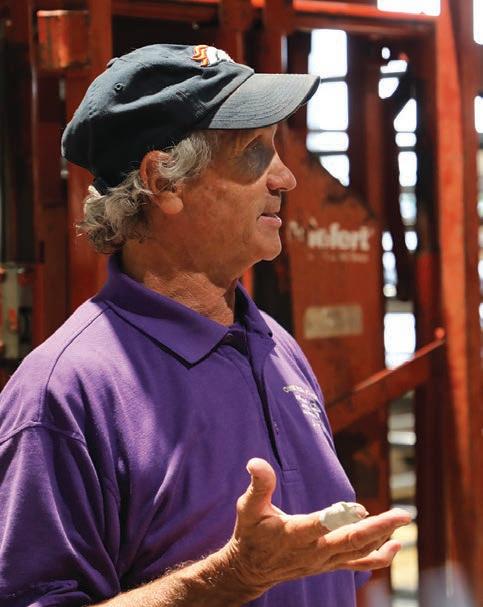

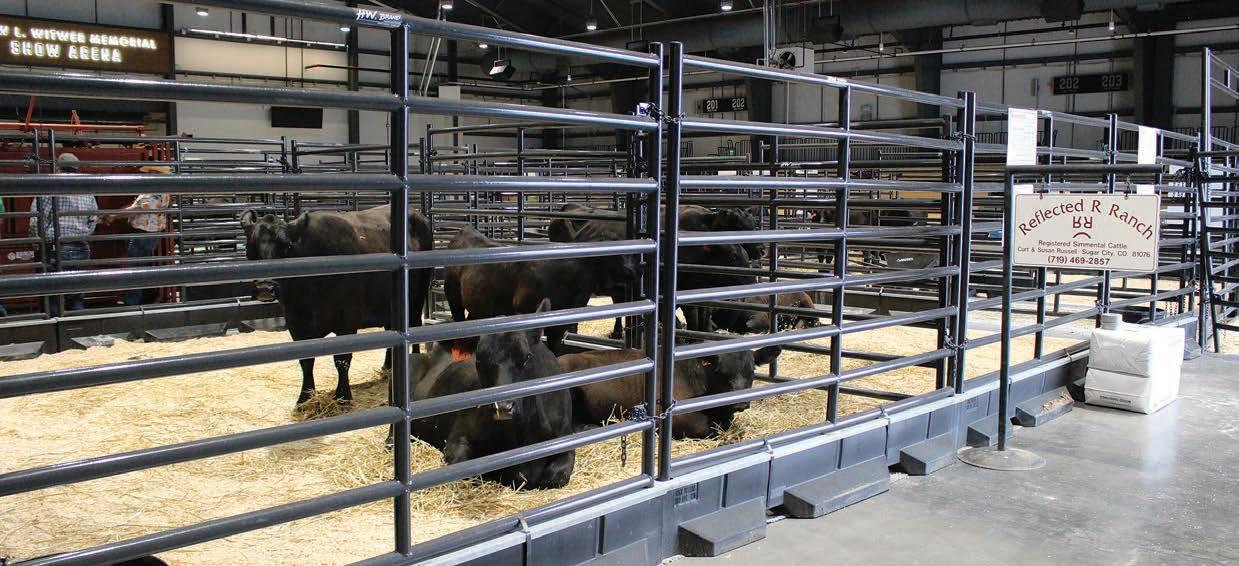
October 2023 / Register 21
Opposite: ASA Geneticist Lane Giess gave a feet and leg scoring demonstration. Above: Colorado Simmental breeders brought cattle for display at the HW Hutchison Family Stockyards Event Center. Right: Lane Giess.
Bottom, L to R: Dr. Tim Holt led a live PAP demonstration. Attendees watched the monitor as Holt explained the measurement process.
gathering
A Look Back Fall Focus 2023
(Continued from page 21)
symposium

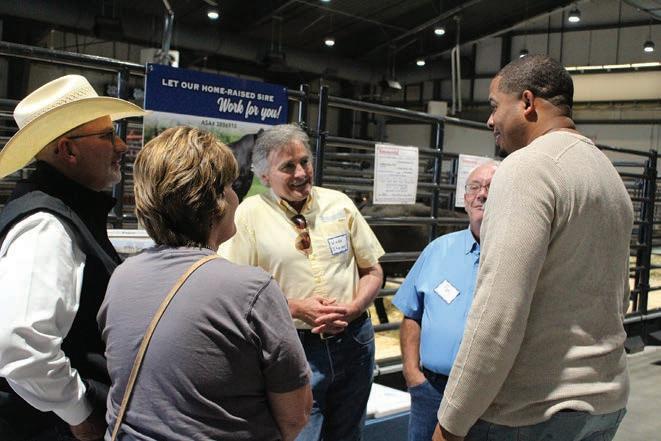
Saturday’s Educational Symposium took on a new format. Dr. Jackie Atkins set the tone for the day, challenging attendees to “Walk Around the Cylinder” and consider multiple perspectives before drawing conclusions. The remainder of the morning was spent taking a deep dive into bovine heart health, focusing on bovine congestive heart failure (BCHF) and PAP. Given 20 minutes to hit the high points in “Ted Talk” style presentations, five of the topic’s experts shared their knowledge. The high-caliber speaker line-up consisted of Dr. Tim Holt, DVM, of CSU, Dr. Brian Vander Ley, DVM, of University of Nebraska–Lincoln, Dr. Mark Enns of CSU, Dr. Scott Speidel of CSU, and Dr. Justin Buchanan of J.R. Simplot Company.
Why was it important to spend all morning listening to these presenters? BCHF and PAP are perhaps two of the most pressing and economically relevant issues within the beef industry today. With the frequency of heart failure increasing in feedlot cattle, finding a solution is a top priority for many university and industry researchers, who are working diligently to identify BCHF risk factors and genetic correlations. Bovine pulmonary hypertension is essentially critically high blood pressure in the vessels that run from the heart into the lungs. Related to PAP, it can be triggered at high elevations when lower oxygen levels are available, causing high-mountain disease and then brisket disease when body fluid pools and causes swelling in the brisket area. Hence, the importance of PAP testing, genetics, and thoughtful breeding programs

 L to R: ASA EVP Dr. Wade Shafer conversing with Fall Focus attendees. The Colorado Simmental Association and Colorado Cattlemen’s Association hosted a day focused on the state’s beef industry, capping the day with a tri-tip dinner.
ASA’s Dr. Jackie Atkins kicked off the educational symposium.
L to R: ASA EVP Dr. Wade Shafer conversing with Fall Focus attendees. The Colorado Simmental Association and Colorado Cattlemen’s Association hosted a day focused on the state’s beef industry, capping the day with a tri-tip dinner.
ASA’s Dr. Jackie Atkins kicked off the educational symposium.
22 Register / October 2023
is crucial, especially to those raising cattle in highelevation areas or providing genetics to individuals raising cattle in that setting.
Lane Giess moderated the monumental panel discussion with the heart health speakers. The audience got one-and-a-half hours to ask the experts any and all questions. Not a second was spared, with many questioning management implications, the role of genetics, and tangible steps that can be taken now to decrease the likelihood of the issues.
After an informative state of the beef industry update from Billy Schmitz with Five Rivers Cattle Feeding, Steve Wooten took the stage to discuss his experience as the chair of the US Roundtable for Sustainable Beef (USRSB). The USRSB holds a proactive mindset and believes it’s best to bring everyone from the beef supply chain to the


table when discussing sustainability. A couple of Wooten’s comments resonated with the audience, such as the need to keep working lands in working hands, and the importance of being involved in the conversation to help ensure success for the next generation and future stewards.
Chip Kemp moderated the sustainability panel discussion that followed and included Wooten, Dr. Sara Place of CSU, Dr. Scott Howard of Meyer Natural Foods, and Dr. John Crowley of AbacusBio. The panelists tactfully navigated what can be a sensitive topic, recognizing that while keeping sustainability measures in mind is essential, we still have to produce food. Furthermore, all panelists communicated their ideas for what genetics producers should be selecting for, Crowley and Place agreeing that traits like stayability and fertility are key, with Howard adding the importance of cutability and quality.
(Continued on page 24)
October 2023 / Register 23
Lane Giess (far left) moderated a panel discussion focused on bovine heart health. The speakers (L to R) included Justin Buchanan, Dr. Bryan Vander Ley, Dr. Scott Speidel, Dr. Mark Enns, and Dr. Tim Holt.
Chip Kemp (far left) moderated the panel discussion focused on sustainability. The speakers (L to R) included Dr. Sara Place, Steve Wooten, Dr. Scott Howard, and John Crowley.
A Look Back Fall Focus 2023

(Continued from page 23)
Saturday evening was a time for visiting, networking, and celebration. The Golden Book Award recipients, 2023 Lifetime Promoter, retiring ASA trustees, and outgoing chairman were recognized. Well-deserving Golden Book recipients Neil Martin, Jim Largess, and Cynthia Conner were in attendance with their families to accept their award. Sunday morning started with a Town Hall meeting, which gave Fall Focus attendees the opportunity to ask questions of board trustees and staff members. These exchanges sparked discussions that continued into the committee meetings. n
Please make plans to join us for Fall Focus 2024 in Amarillo, Texas


24 Register / October 2023
Above: Fall Focus attendees gathered to celebrate the Golden Book and Lifetime Promoter award recipients, as well as retiring trustees.
Right: Simmental enthusiasts representing 28 states and three provinces attended the 2023 Fall Focus event.
celebration

Mark Your Calendars for 2023–2024 Major PTP Open Shows
Visit event websites for show schedules.
American Royal
October 2023
www.americanroyal.com
North American International Livestock Exposition
November 2023
www.livestockexpo.org
This is the National SimGenetics Show for 2023–2024
Cattlemen’s Congress
January 2024
www.cattlemenscongress.com
National Western Stock Show
January 2024
www.nationalwestern.com
Fort Worth Stock Show
January 2024
www.fwssr.com
Dixie National Livestock Show
February 2024
www.dixienational.org
The American Simmental Association is proud to sanction high-quality Purebred Simmental, Percentage Simmental, and Simbrah Progress Through Performance (PTP) shows throughout the country. The PTP program is designed to promote multi-level progress within the SimGenetics industry. PTP shows effectively combine the assessment of statistical data, such as EPD and actual measurements, with traditional phenotype evaluation.
PTP Judges
PTP approved judges have been deemed as respectable and knowledgeable cattle evaluators by the ASA Board of Trustees Activities & Events (A&E) Committee. View the PTP approved judges list at: www.simmental.org.

Only the Major PTP Shows involved in the National Show rotation are eligible for ASA PTP RING OF CHAMPIONS 2023-2024.
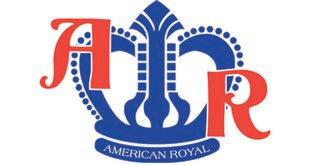

Shows include: 2023American Royal
2023North American International Livestock Exposition


2024Cattlemen’s Congress

2024National Western Stock Show
2024Fort Worth Stock Show
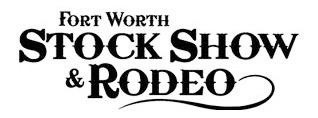
2024 Dixie National Livestock Show

Award Divisions
u Purebred Simmental Female of the Year
u Purebred Simmental Bull of the Year
u Percentage Simmental Female of the Year
u Percentage Simmental Bull of the Year
u People’s Choice Female of the Year
u People’s Choice Bull of the Year
Qualifications
u Exhibitors must be active members in good standing with the American Simmental Association
u Purebred Simmental: 7/8 Simmental and up
u Percentage Simmental: at least 1/2 Simmental, but less than 7/8 Simmental
u Animals and their exhibitors must abide by the rules of the show(s) in which they participate
u All ASA Ring of Champions award winners must at a minimum complete an ultra-low density DNA test before awards are given
Additional information
PTP Coordinator


Chance Ujazdowski
920-740-7536
chanceu@simmgene.com
STYLE 2023 Future
 by Sarah Goss, participant
by Sarah Goss, participant
The second annual SimGenetic Training for Young Leaders and Entrepreneurs was held in Oklahoma City June 9–11. The event gathers young people from across the country to focus on leadership and self discovery, learn about ASA governance, and build relationships with other leaders in the industry.
Leadership — true leadership — looks different. It has to. Or organizations (and the people and ideas that drive organizations) can’t move forward.
For three days in Oklahoma City in mid-June, ten members of the American Simmental Association participated in SimGenetics Training for Young Leaders and Entrepreneurs (STYLE), and had the opportunity to get an inside look at how the people and ideas driving ASA are moving forward. Differently.

The young leaders that gathered from across the county were as unique and diverse as the flow and structure of the STYLE event. A few of the inspiring interactions and experiences I observed included:
n A barely-getting-started small breeder from Wisconsin meets a fifth-generation operation from Alabama.
n Discover and define personal core values assignment followed by an in-depth discussion on Economically Relevant Traits.
n Young breeder relocates from West Virginia to Kansas and meets up-and-coming leader in a genetics company. They share a table with industry-seasoned Simmental breeders/mentors from Alabama and Colorado.
n Conversation on “Good to Great” Level 5 Leadership transitions into discussion on growth and opportunities in natural and source-branded meat products. Clearly, the agenda bounced from personal leadership to industry experts to association history to the intricacies of EPD. And it worked.
A day in the life of a Simmental producer bounces from the basics of animal husbandry to forward-looking genetic decisions to finance and economics to rolling up shirtsleeves and volunteering at a junior stock show. Bouncing, adapting, and demonstrating competencies at every stage is what it takes to succeed in today’s beef industry.
And today’s beef industry — and the success of the beef industry — is the singular measure of success for ASA. Members’ cattle, plus science, technology, and collaboration, exist to serve the beef industry. It’s that simple. Dr. Wade Schafer said so.
When the beef industry succeeds, so do ASA members. And when that singular focus is the target of every employee and every member of the Association, the cattle get better, the breed grows, memberships grow, junior programs grow, the Association moves forward.
So simple. Yet, so refreshing. Over the course of the weekend in Oklahoma City, it was said, “Our model may not look like everyone else’s, but that’s ok.”
The model is a fresh take on an old industry. STYLE participants left Oklahoma City different than when they arrived. And that’s ok. n
Sarah Goss makes her home in Kansas with her husband Brent and four children: Noah, Tucker, Nell, and Britta. She is the co-founder of Roots and Legacies, an agricultural consulting agency. She started her career in economic development, and later moved to banking. The Goss family owns a farm, and is actively involved in their community, 4-H, and more.

28 Register / October 2023

An Opportunity More Value
by Wyatt Bechtel, Filament Ag

Breeding with sexed semen can help your bottom line by creating cattle the market demands.
Sexed semen breeding programs for the beef industry have primarily focused on developing genetically superior replacement heifers.
“Male sexed semen is an opportunity to capture value. The opportunity is greater when the price spread between steers and heifers is significant,” says Ken Odde, DVM and PhD, professor and department head emeritus of the Department of Animal Sciences and Industry at Kansas State University.


Value of breeding for males
Before breeding with sexed semen, Odde looked back at industry trends to see the economic impact of breeding for more males.
“We’ve got years of history when most sexed semen was targeted at producing females,” Odde says. “Breeding for males is a shift in thinking, and ultimately it’s driven by how high the price difference is between steers and heifers.”
Data from Superior Livestock (see Figure 1) shows the price per hundredweight (cwt) difference between steers and heifers has been on an upward trend for nearly three decades. Odde says the price difference between steers and heifers has been primarily driven by increasing carcass weights and the rising cost of gain.
Since retiring from academia, Odde has focused on creating more profitability for his family’s commercial cow-calf ranch in South Dakota.
“About six years ago, I was sitting at the sale barn in Mobridge, South Dakota, and the price spread between steers and heifers just struck me that day,” Odde says.
From that “aha moment,” Odde started to pursue what a sexed semen breeding program could look like for his ranch. He shares strategies and protocols to consider for success, including fertility differences between cows and heifers, the use of split-time or fixed-time artificial insemination (AI) and the value of using breeding indicator patches to measure estrus intensity.
Feedlot closeout performance data in Kansas (see Figure 2) from August 2017 showed the average cost of gain was $5.66 per cwt higher for heifers versus steers. That year corn was relatively cheap to feed at $3.91 per bushel. In August 2022, the average cost of gain was $12.77 per cwt higher for heifers than for steers when the corn price was $8.69 per bushel.
“Steers can be fed to higher weights more efficiently,” Odde adds. “The trend of increasing carcass weights could be a driver of producing more male calves with sexed semen, particularly when feed prices are higher.”
30 Register / October 2023
1995 527 67.55 6.83 2000 540 100.06 8.00 2005 575 121.43 9.04 2010 567 118.77 10.68 2015 578 248.39 20.94 2020 580 154.22 15.81 2021 572 172.50 18.47 Year Mean Base Mean Price Price Spread between (lbs.) 100 lbs. (US$) Steer and Heifer Lots (US$/100 lbs.)
Dr. Ken Odde served as Department Head for the Animal Sciences and Industry Department at Kansas State University from 2007 to 2018. Dr. Odde now works full-time on the family ranch in South Dakota and serves as a SimSpecialist for ASA.
Figure 1: Value of Heifer Calves Relative to Steer Calves, Superior Livestock Data, 1995–2021.
On-ranch experience
The first set of females to be bred with sexed semen on Odde’s ranch used maternal female sexed semen on heifers (see Table 1) and predominantly utilized terminal male sexed semen on cows (see Table 2).
Some breeding indicators have easy-to-read bullseyes (black surface ink) on them. Once the bullseye (or the equivalent surface area) is rubbed off the animal, that animal is ready to breed and is up to three times more likely to result in a confirmed pregnancy.
(Continued on page 32)

October 2023 / Register 31
August 30,069 766 1,439 180 3.61 6.02 2.06 129.41 2022 (steers) August 25,912 736 1,296 169 3.14 6.52 2.72 142.18 2022 (heifers) August 34,951 793 1,379 169 3.62 6.05 1.27 73.88 2017 (steers) August 22,764 711 1,231 165 3.11 6.61 1.69 79.54 2017 (heifers) Closeout # of In Weight Final Weight Average Days Average Daily Feed to Gain Death Average Cost of Date Head (lbs.) (lbs.) on Feed Gain (lbs./day) (Dry Basis) Loss (%) Gain/CWT (US$)
2019 Female Angus 101 MGA-PGF2α Breed by Estrus 64 63.4 2021 Female Simmental 69 MGA-PGF2α Breed by Estrus 40 58.0 2021 Female Angus 73 MGA-PGF2α Breed by Estrus 41 56.2 2022 Male Angus 148 MGA-PGF2α Breed by Estrus 77 52.0 Year Semen Breed # of Estrus Synchronization Breeding # Pregnant A.I. Pregnancy Gender of Sire Heifers Protocol Protocol A.I. Rate (%)
Figure 2: Gender Performance Differences in Feeder Cattle, Focus on Feedlots, Kansas State University. August 2022 corn price = US$8.69/bushel and August 2017 corn price = US$3.91/bushel.
2019 Male Charolais 88 CO-Synch-CDIR FTAI 36 40.9 2019 Male Charolais 80 CO-Synch-CDIR STAI 36 45.0 2019 Female Angus 51 CO-Synch-CDIR STAI 24 47.0 2021 Male Charolais 204 CO-Synch-CDIR or 7&7 Synch FTAI 96 47.0 2022 Male Charolais 46 CO-Synch-CDIR FTAI 24 52.2 2022 Male Charolais 78 CO-Synch-CDIR FTAI 35 44.9 Year Semen Breed # of Estrus Synchronization Breeding # Pregnant A.I. Pregnancy Gender of Sire Cows Protocol Protocol A.I. Rate (%)
Table 1: AI Pregnancy Rates for Gender Sorted Semen in Yearling Heifers, 2019, 2021, and 2022.
Table 2: AI Pregnancy Rates for Gender Sorted Semen in Cows, 2019, 2021, and 2022.
Sexed Semen: An Opportunity Capture More Value Cattle
(Continued from page 31)
Following an estrus synchronization protocol, heifers were bred by visual heat detection using ESTROTECT Breeding Indicator patches to aid in estrus detection during five days of monitoring. The heifers’ AI pregnancy rate was 63.4%.
In the first year, cows were bred using multiple protocols. With fixed-time AI, cow reproduction rates were 40.9%. Two cow groups were bred using split-time AI at 70 hours post prostaglandin injection for cows with activated ESTROTECT patches. If patches weren’t activated, insemination happened at 90 hours with an injection of GnRH. The split-time groups had pregnancy rates of 45% and 47%.
“We think with split-time AI, we were able to pick up a few more cows running them through a second time,” Odde relates. “However, it is pretty labor intensive, so we’ve moved towards more fixed-time AI with the cows.”
In the third year of research, male sexed semen was used across all the heifers and cows. “We have learned we get better fertility on our yearling heifers than on mature cows,” Odde says. “We can easily produce more bull calves from our heifers, so that’s something we want to evaluate further.”
Words of advice
If you are considering breeding with sexed semen, Odde has a few tips. Odde suggests using a protocol that helps make chute-side breeding decisions based on estrus intensity via a breeding indicator patch.
If half of the patch or more is rubbed off, females are good candidates to be bred with sexed semen. Should less than half of the patch surface ink be rubbed off, it’s best
to use less expensive conventional semen to help manage costs of your genetics investment.
Keeping an eye on market trends is another management practice to consider. “You need an understanding of the economic dynamics,” Odde says.
For some herds, it may work better to develop more replacement heifers via sexed semen and marketing those replacements to terminal-focused operations, particularly when replacement females are in demand.
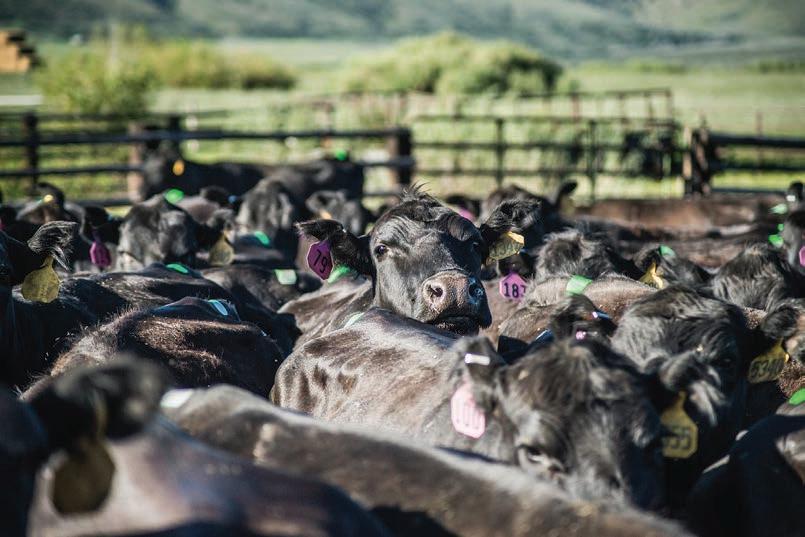
“It could be that male sexed semen works well in some situations, and a few years later, it may not have the same incentive,” Odde adds. “When there is a good price difference between steers and heifers, it can really work well.”
Odde presented his on-ranch research findings during the Beef Improvement Federation Annual Symposium in Calgary, Alberta, Canada, on July 3. n
Editor’s note: This piece was originally published by ESTROTECT. For more information go to ESTROTECT.com.
Dr. Ken Odde is a longtime Simmental breeder, and currently serves as a SimSpecialist.
Wyatt Bechtel is a manager at Filament Ag, a marketing and communications firm based in Wisconsin. Bechtel is a writer and communicator, and also spends time at his family’s ranch in the Flint Hills of Kansas. The business includes a custom grazing stocker operation, a commercial Angus cow/calf herd, outfitting deer hunters, and hosting bird dog field trials.
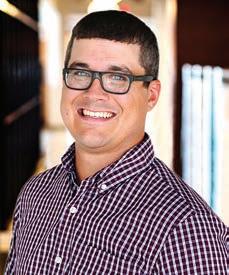
32 Register / October
2023
The breeding indicator’s surface ink is rubbed off by friction during mounting and reveals an indicator color. When enough color is exposed, the animal is considered ready to breed.

AJSA CONNECTION

Developing leaders through friendship, networking, and communication skills!
by Blake Fabrizius, Western Region
Upcoming PTP Schedule
As many of us are getting settled into the school year I thought it would be a good time to catch up on the upcoming Progress Through Performance (PTP) schedule. First up, The American Royal in Kansas City, Missouri. The 124th annual American Royal’s tentative schedule lists Tuesday, October 17, and Wednesday, October 18, as Simmental move-in days. The Junior Simmental show will occur on Friday, October 20, and be sorted by Amanda Schnoor with the Supreme Junior Heifer drive the following day. Jeff Paulsen will be joining us on October 22 for the Open show.
The North American International Livestock Exposition (NAILE) in Louisville, Kentucky, takes place November 2–16. The Junior Simmental show will take place in Broadbent Arena starting at 8 AM on Saturday, November 11, with the Junior SimSolution show the following day in Freedom Hall after the conclusion of the Junior Angus show. Fullbloods will show following the Chianina and Limousin shows in Broadbent Arena. The Junior Heifer show Supreme Drive will start at 5:30 PM in Freedom Hall on Sunday, November 12. All Simmental cattle showing in the Open show will exhibit on Tuesday in Freedom Hall
starting with the Fullblood show at 8 AM . Judges Andy Higgins and Ryan Haefner will sort the Junior Simmental/SimSolution and Junior Fullblood Simmental shows, respectively, while Matt Aggen will sift the Open Simmental cattle. Don’t forget, NAILE is our 2023–24 PTP National SimGenetics Show! All dates and times were updated as of June and are tentative.
Cattlemen’s Congress in Oklahoma City is approaching its 4th annual event. The Junior Simmental Show is scheduled for January 8, while the open show will take place on both the 8th and 9th. Lydell Meier will evaluate the junior show, with Scott Trennepohl on the Open show. Turn to the next week on the calendar for the National Western Stock Show (NWSS) Simmental schedule. Denver, Colorado, is excited to welcome Cary Crow to sort the Junior show on January 15, and Brent Murphy for the Open show the following day.

Just 12 short days later on January 28, judge Shane Bedwell will give his thoughts on the Open Simmental show at the Fort Worth Stock Show. The AJSA Board of Trustees is ecstatic to see all our junior and open show exhibitors take on the busy yet exciting PTP shows. We will have several board members present at each show who will be working rings and happy to help in any way so please don’t hesitate to ask! n
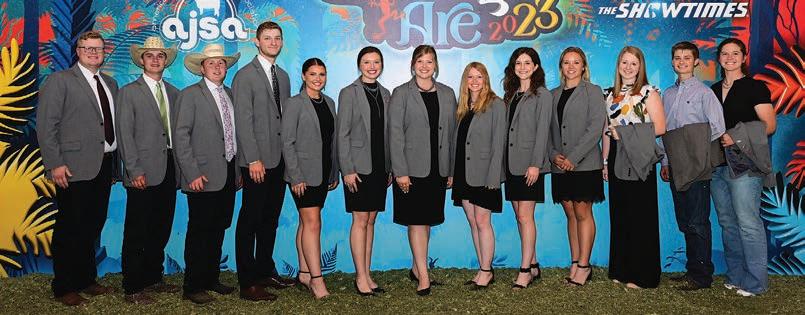
Eastern Region
Chase Harker Hope, IN 812-371-9591 chaseharker1902@gmail.com
Walker Housley Dayton, TN 423-599-8346 walkerhousley@gmail.com
Matthew Koverman Minford, OH 740-988-0203 koverman.18@osu.edu
Garrett Walther Centerville, IN 765-238-8584 gwalther55@gmail.com
North Central Region
Jazlynn Hilbrands Holloway, MN 320-297-1611 jmhilbrands@gmail.com
Emerson Tarr LeRoy, IL 309-205-0860 eleetarr2021@gmail.com
Anna Webel Farmington, IL 217-840-2470
anna.g.webel@gmail.com
South Central Region
Kaitlyn Cloud Carthage, MO 417-793-7824 kcloud2002@gmail.com
Hallie Hackett Texarkana, TX 903-748-0345
halliehack10101@gmail.com
Anna Sweat McCaskill, AR 479-970-6904 anna.sweat.06@gmail.com
Western Region
Bella Beins Deweyville, UT 435-452-2391 bella.beins@gmail.com
Blake Fabrizius Carr, CO 970-556-9115 bwfabrizius@gmail.com
Jonna McCullough Fort Benton, MT 406-868-0253
mcculloughjonna1@gmail.com

34 Register / October 2023
www.juniorsimmental.org
2023–2024 American Junior Simmental Association Board of Trustees
Editor’s note: A schedule of PTP shows appears on pg. 26.
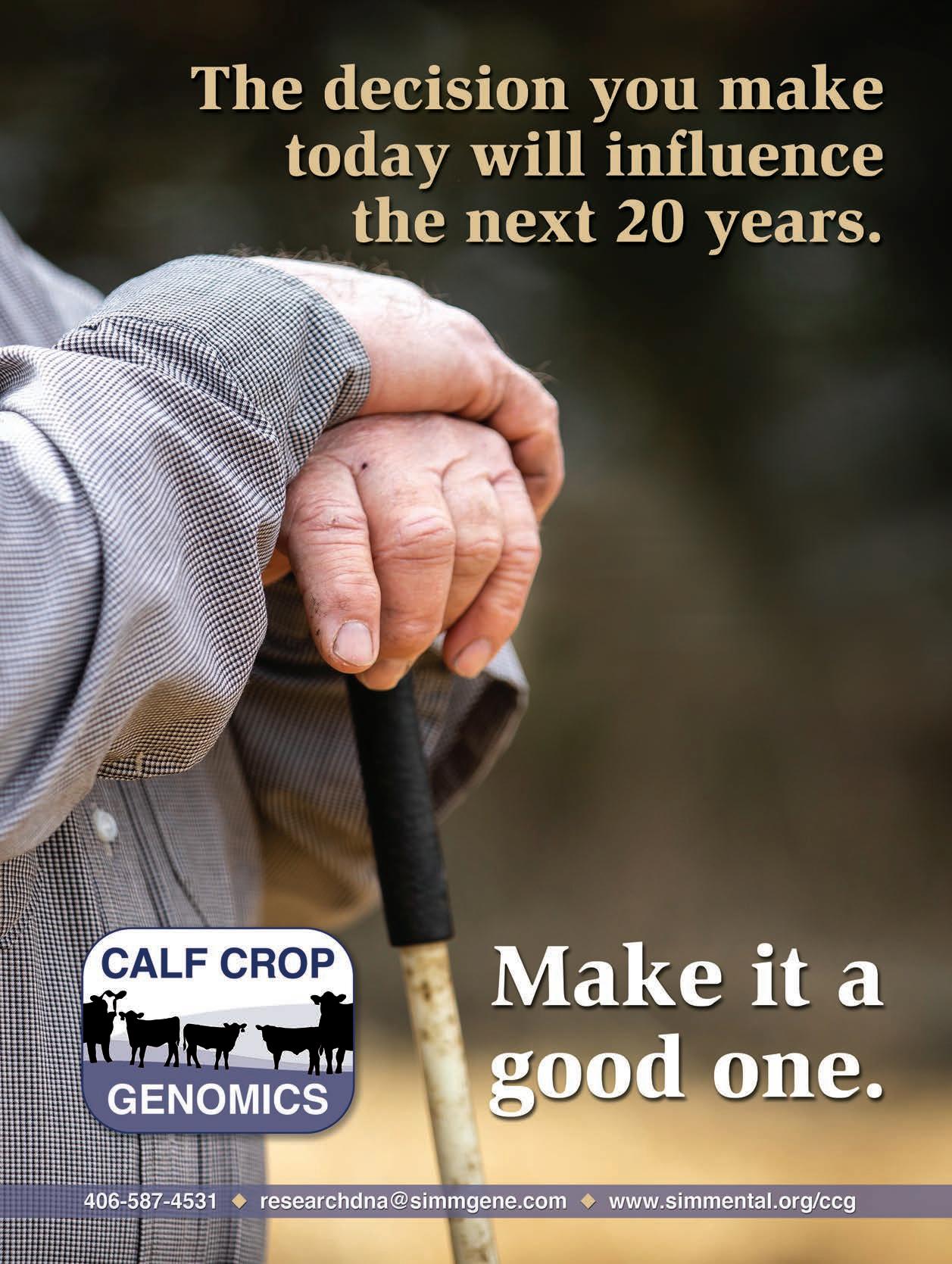 by Larry H. Maxey, founder and superintendent, NAILE Fullblood Simmental Shows larryhmaxey@gmail.com
by Larry H. Maxey, founder and superintendent, NAILE Fullblood Simmental Shows larryhmaxey@gmail.com
Our Pioneers — Pat Garrett
You may recall the conclusion of this column for the July/August issue of the Register and the reference to Pat Garrett. In that piece, much attention was given to the infamous Lincoln County War in the New Mexico Territory, beginning in 1878. It was a brutal war. Essentially all involved ended up either wounded or dead. The few survivors suffered huge financial and reputational losses. Such is the case with all wars.
In 1880, a newcomer to the area, Pat Garrett, was elected as sheriff. Lawlessness and violence were out of control. Garrett’s task was to stop it. No small feat given the many outlaw groups that thrived unabated. Who in their right mind would undertake such a risky challenge? Garrett appeared to have no qualms. So who was this guy with apparent nerves of steel?
Patrick Floyd Jarvis Garrett was born June 5, 1850, in Chambers County, Alabama. He was of English ancestry. Coincidentally, one place of the family’s origin in England was listed as Northamptonshire, which includes the Village of Maxey. When my wife and I visited there a few years ago we learned the Maxey name has been in continuous use for over 1,000 years.
When Garrett was three his father purchased the John Greer Plantation in Claiborne Parish, Louisiana. The Civil War destroyed the family finances. By age 18, Garrett had lost both his father and mother. He and his siblings were left with a debt of $30,000. In 1869, Garrett headed west, apparently wandering around for seven years; his whereabouts were unknown until he surfaced in Texas in 1876. He had been hunting buffalo. During a confrontation with another buffalo hunter, Joe Briscoe, Briscoe was shot and killed. Garrett surrendered to the authorities at Fort Griffin, Texas, but they declined to prosecute.
Following his buffalo hunting years, Garrett rode west to New Mexico Territory and Fort Sumner. There he made efforts to settle down and start a family. This was hard to do with the Lincoln County War raging. He decided to run for sheriff and surprisingly was elected on November 2, 1880, defeating the incumbent Sheriff George Kimbell with 320 votes to 179.
After taking office, he obtained a deputy US Marshall’s commission. This allowed him to pursue outlaws across state lines. Among those many notorious criminals was his main target, William H. Bonney, a.k.a. “Billy the Kid.” With posse in tow and certain that the “Kid” was at the Dedrick Ranch at Basque Grande, they stormed the ranch on November 30, 1880. The Kid was not there. Several other outlaws were apprehended and turned over to the sheriff of San Miguel County.
Continuing his search, in the settlement of Puerto de Luna, a local thug named Mariano Leiva picked a fight with Garrett and was shot in the shoulder. More gang lawlessness ensued. Emboldened with perceived invincibility, the Kid and his cohorts brazenly rode into Fort Sumner with Garrett and his posse lying in wait. A shootout ensued and once again Billy escaped. Garrett followed him to Stinking Springs where Billy was captured.
On April 15, 1881, Judge Warren Bristol sentenced Billy to be hanged. Awaiting final justice, somehow he managed to escape
jail. Within two weeks he had murdered two deputies. A determined Garrett was in dogged pursuit. Rumor had it that Billy was holed up with Pedro “Pete” Maxwell at his house. Garrett waited until midnight and entered the house. He shot and killed Billy.
To this day, controversy and uncertainty remain as to the events of that fatal night. Various accounts by many historians over the years have tried to glorify the life of Billy the Kid and claim less heroic actions by Garrett in the Kid’s demise. One has to remember that Garrett was ordered to bring in the Kid, “dead or alive!”. Whatever the factual circumstances were, “Law and Order–Old West Style” had been rendered. The courage of this lawman had drawn the region one step closer to the rule of law.
Following his stint in New Mexico, he moved on to Texas. He ran unsuccessfully for state senate. He became a captain in the Texas Rangers but gave it up within a month and headed back to Roswell, New Mexico. There he was involved in various business ventures which all failed. By 1892, he moved his large family back to Texas. In Uvalde, he became friends with John Nance Garner, who would later become a US Vice President.
Lawlessness in New Mexico was surging once again. He was drawn back to help get things under control. Multiple episodes ensued and true to his core, he pursued justice with unwavering gusto. The West was his domain. Countless outlaws knew his name and shivered in fear when they knew he was on their trail.
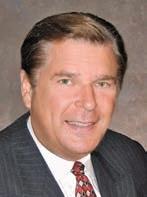
The remainder of Garrett’s life was filled with controversy. His heroic reputation led President Theodore Roosevelt to appoint him to the post of Collector of Customs in El Paso on December 16, 1901. That reputation soon became tarnished. Allegations of incompetence swirled, along with a long list of infractions, both personal and professional. Roosevelt was forced to replace him.
Garrett’s financial troubles were large. Continuing his efforts to right them led to a dispute over a livestock transaction and a confrontation in which Garrett was shot and killed. By whom was never factually determined. He died February 29, 1908. His ending fits a pattern of how the peace was “kept” in the lawless West. He was indeed a Western hero, however immensely complex, controversial, and enigmatic his legacy may be. n
Editor’s note: This is the thirty-first in the series Our Pioneers.
Is there a Simmental pioneer who you would like to see profiled in this series? Reach out to Larry Maxey or the editor to submit your suggestions:
larryhmaxey@gmail.com • editor@simmgene.com

36 Register / October 2023 FLECKVIEH FORUM
Included with printed catalogs:
To receive a quote or for more information contact: Nancy Chesterfield
406-587-2778
Our low-cost, full-color printing options may just surprise you! Our talented catalog production team uses their skills to provide each customer with pieces guaranteed to impress. With our direct access to ASA’s database and vast photo library we make the process simple and easy! • Online catalog flipbooks • Downloadable pdfs • Free mailing lists • One free eBlast

nchesterfield@simmgene.com
www.simmental.org
Additional Ad Design Services
Our experienced design staff can assist you in developing any form of creative printed promotion. These are just some of the products we produce:
u State directories
u Brochures
u Flyers
u Photo retouching
u Postcards
u Booths
u Logos
u Business cards
u Websites
u Banners
u Posters
u eBlast ads
American Simmental-Simbrah Foundation Raises $14,500 at AJSA National Classic
by Carrie Horman, CNN Cattle Company
The week of the AJSA National Classic brings a lot of anticipation for something new, what is going to take place, excitement for the old traditions to carry on, and everything in between. The American Simmental-Simbrah Foundation (ASF) had a lot of the same emotions going into the 2023 National Classic with hosting of the seventh annual Breeders Cup Golf Tournament, and kicking off the inaugural Barbecue Contest. Both events are designed to raise funds for the youth of the Simmental breed for the Merit Scholarships and Leadership Workshop.
The grills, smokers, and crock pots of six teams rolled up on Sunday, July 9, for their opportunity to showcase how they could prepare and present a tri-tip roast, shoulder tender, beef short ribs, Iowa sweet corn, and a dish of their choice for the open category.

Four judges evaluated all categories based on presentation, taste, tenderness, and overall effectiveness of the beef cut, sweet corn, and open category, which included desserts, dips, and more. A People’s Choice vote also took place as teams prepared samples for the audiences to taste and vote on by placing cash in the team’s jar.
After the judges evaluated the dishes, the following won in each category:
Shoulder Tender: Matt, Brandi, and Mason Karisch
Tri-tip Roast: Bradley Warren, Todd Kitzerow, and Kevin Maas
Beef Short Ribs: Thomas Lundy, Blake Runner, and Adrianne Trennepohl
Iowa Sweet Corn: Thomas Lundy, Blake Runner, and Adrianne Trennepohl
Open Category: Thomas Lundy, Blake Runner, and Adrianne Trennepohl
Overall Team: Thomas Lundy, Blake Runner, and Adrianne Trennepohl
People’s Choice Award: Steve and Kristen Hicks
Then on Monday, July 10, the seventh annual ASF Breeders Cup Golf Tournament returned to the great state of Iowa, where it all began! Twenty-five teams made their way to the Bright Grandview Golf Course for a fun-filled day out on the course. Teams from all over the country came together for a little friendly competition of golf strategy, birdies, some cow talk, some trash talk, and a whole lot of laughs.
“This is so much fun, I look forward to this every year,” said Kyle Hotz of Hotz Cattle Company.
A lot of conversation on recipes, how to prepare different cuts of meat and “oh my that was incredible,” was overheard all day as the teams tended to their secret method of preparing for turnin time to the judges. “This is the most fun I’ve had at a Junior National,” said Thomas Lundy, leader of Team 1.
The course was tight and short, which made for a different strategy in many players’ games. The “Purple Ribbon Beef” team, made up of Jess Recknor, Nick Zastrow, Jayson Olson, and Trevor Biley, came out on top with a score of 56. We’re all about hanging banners in this business; the Champion team can now hang their banners and hold bragging rights until 2024! Buck Creek Cattle with Jacob Moore, Justin Johnson, Garret Cloud, and Kent Jaecke were our reserve champion team.
Individual contests were set up as the players shot their 18 holes for added fun and competition. It’s always fun to see the ladies getting in on the competition as well! Sheryl Clanton from Kansas took home the Longest Putt championship. We had two Closest to the Pin competitions where Ryan Mesch won Hole 9 and Mark Schoenfeld won Hole 13.
Together the BBQ Contest and Golf Tournament raised over $14,500 to go back to our Simmental kids. We could not have done that without the donations of all our sponsors of the events, and cannot say THANK YOU enough for your support and generosity.
Make plans for the 2024 AJSA National Classic to be held in Tulsa, Oklahoma, July 7–13. Plans are already in the making for the second annual Barbecue Contest and eighth Annual ASF Breeders Cup Golf Tournament. n


38 Register / October 2023
FOUNDATION FOCUS
Competitors gathered for the first annual Barbecue Competition at the AJSA National Classic.
The ASF held their seventh annual Breeder’s Cup Golf Tournament.
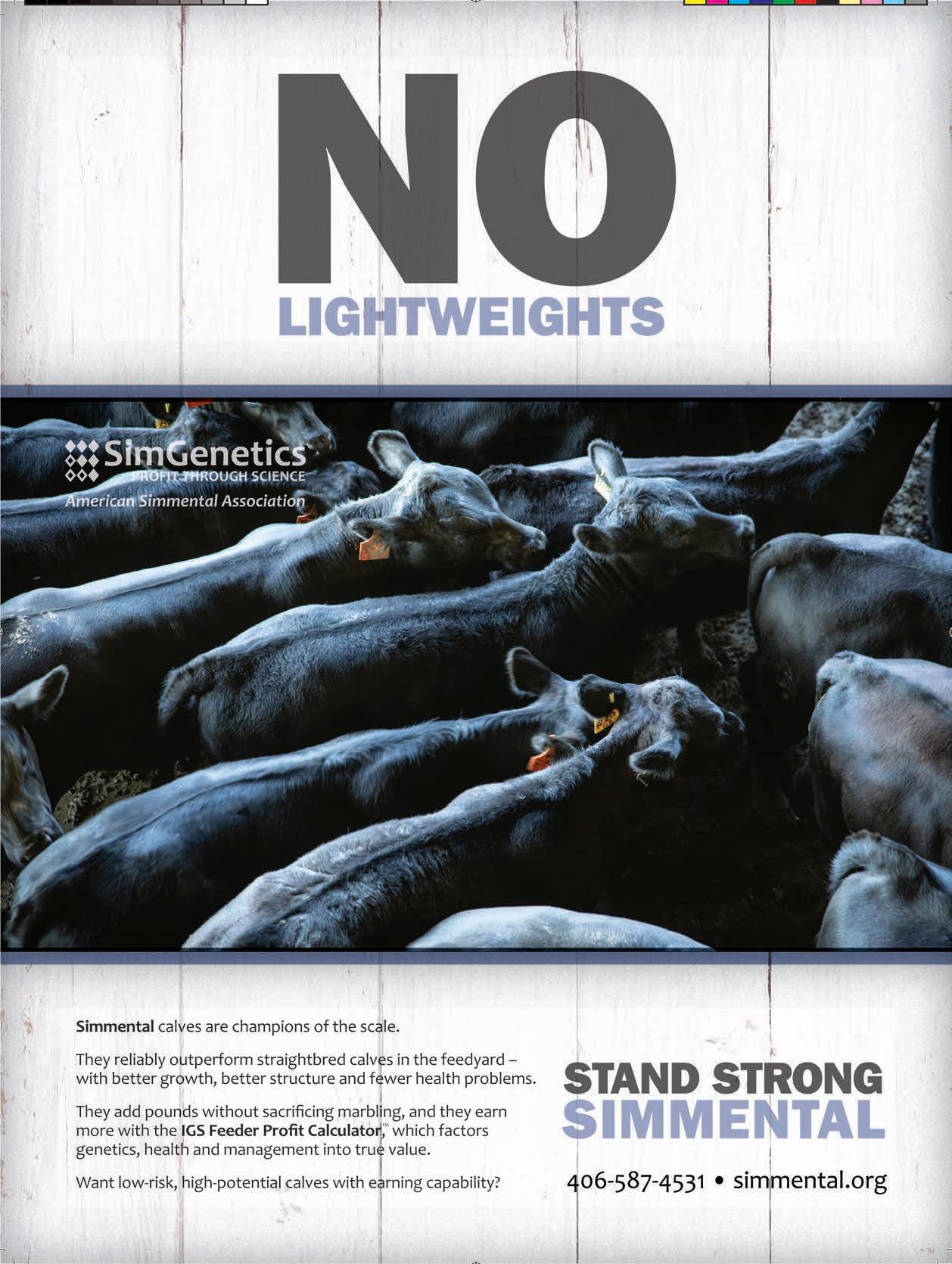
Hydrops Pregnancies in Simmentals
Seeking reports of active cases
The Nebraska Bovine Congenital Defects program recently recognized an increased number of reports of hydrops pregnancies in a line of Simmental cows. Hydrops is expressed by females developing markedly enlarged abdomens in late pregnancy due to a dramatic excess of fluid in the fetal membranes. At present, these cases point to a genetic link but the pattern of inheritance and percent of affected offspring is unknown. Reports involve daughters and granddaughters of the bull WS All Aboard B80, ASA #2852207.
For the most up-to-date information, please see the “Further Information” link on Simmental.org. A webinar discussing what is currently known with the University of Nebraska–Lincoln and ASA team is available at simmental.org. Finally, if you have a potential case to report, please use the “Report Case” link at simmental.org to provide us with your contact information, and a team member will get back to you soon.
Stay Involved with Trustee Elections and Rule & Bylaw Changes
ASA’s fiscal year ended on June 30, which means you likely noticed the Annual Membership Fee charged to your Herdbook account. There are two important steps to remain active:
1. Pay your Annual Membership Fee.
2. Register and/or transfer at least one animal record within two years.
Your account must be in active status in order to elect trustees from your region and to vote on Rule and Bylaw amendments. We want your voice to be heard, so make sure your account is active today! If you have any questions, contact ASA’s Membership Department at 406-587-4531 or members@simmgene.com.
ASA’s New and Improved Website Is Live
Simmental.org was recently updated to make it quicker and easier for you to find all things ASA related. In addition to the resources you’re used to, it also features a breeder’s resources section that highlights information on SimGenetics, performance data reporting, simple trait selection, and genetic improvement tools. If you have questions or need assistance finding something, contact our office at 406-587-4531.

DNA Updates
DNA Research Fee Application
DNA research fees are $1/minute and may apply to parentage rechecks, misidentified samples, or other scenarios involving unusual increase in staff time. Each case is unique, so estimating the final charge is difficult. If there are a significant number of animals not qualifying to a parent(s), please reach out to the DNA Department to discuss a rough estimate of time and cost.
Testing Timeline
Allow 4–5 weeks. Please communicate any deadlines you may be working with to the ASA DNA staff. Expedited and tracked shipping is always recommended when ordering kits and shipping samples to Neogen.
$30 DNA Research Fee
Sample packages sent to the ASA office (with or without paperwork), instead of the lab, will incur a $30 research fee.
With the exception of research projects (CHR, CCG, CXP), all samples are to be sent directly to the lab with ASA paperwork.
TSU/Applicator Price Increase
Due to rising costs from the TSU manufacturer AllFlexTM, ASA has increased the price of TSU sampling kits to $22 per box. Each box will still include ten individual tissue sampling units. The cost of TSU applicators has also been increased from $40 to $50 each.
Semen Sample Fee
Effective immediately, ASA will be implementing a $7.20 processing fee for all semen straws and/or semen samples submitted to Neogen for DNA testing.
State Association Check-Off Bonus Program Reminder
While the July 15 deadline to submit all state association program requests seems far away, it’s a good time for state associations to familiarize themselves with the check-off bonus program. Aside from the quarterly check-off money states can receive, state associations are also eligible for additional money in the form of yearly bonus checks if certain activities are completed throughout the year. Examples include hosting a field day with ASA representation and participating in the cost share program. To learn about the check-off bonus program, visit simmental.org and contact Callie Cooley at stateassoc@simmgene.com with any questions.
Digital Certificates Available
ASA recently launched a new feature on Herdbook allowing members to download official digital certificates for registered animals. After September 1, 2022, ASA will no longer scan and email or fax copies of printed certificates, and is encouraging shows, sales, and other events to utilize digital certificates. Digital certificates are the easiest, most reliable way to obtain an official record quickly. To download a digital certificate, search for your registered animal on Herdbook. If you are logged in and the animal is registered in good standing, there will be a button to download a digital certificate. Only the current owner of an animal can access the digital certificate. Please contact the registrations department with any questions at simmental@simmgene.com.
DNA Research Programs Continue
The Calf Crop Genomic (CCG) testing project, and Cow Herd DNA Roundup (CHR) continue to accept new submissions. The CCG offers a 50% off GGP-100K genomic test including parentage ($25 compared to $50 equivalent test) to participating breeders who test their entire calf crop group.

The CHR program also continues to accept new herds. The project tests females at $25 per sample for a GGP100K genomic test. Members must test 90% of their calving-age cows to qualify for the reduced price. When members submit mature cow body weights and body condition scores or hip heights on 90% of their calving-age cows, they will receive a $5 credit to their account for each

40 Register / October 2023 BULLETINS
reported cow. Cows must be 18 months of age or older when mature cow measurements are taken to qualify for the $5 credit. The $5 credit will only be applied once in an animal’s life. For example, if a member received a credit for the phenotypes in 2018 for that cow, they cannot receive another credit for the same cow with a new weight and BCS in 2019.
Additional requirements apply for both programs. Please visit simmental.org, and email researchdna@simmgene.com for full program requirements and more information.

2023 Year-Letter is L
In accordance with the Beef Improvement Federation guidelines, the year-letter animal identification for 2023 is L, and will be followed by M in 2024, and N in 2025. The letter K was the year-letter designated during 2022.
Per the BIF guidelines, the following letters are not used: I, O, Q, and V.
CORPORATE REPORT
SEC Urged to Halt JBS US IPO
Environmental groups are calling on the Securities and Exchange Commission (SEC) to call a halt on JBS USA’s US initial public offering over the Brazilian meatpacker’s impact on the climate. Organizations including Rainforest Action Network (RAN) and Mighty Earth have filed complaints with the SEC, urging a probe of allegations against the processor. A spokesperson for RAN said that the organization requests that the SEC conduct a thorough investigation into “the pattern of alarming and unacceptable corporate conduct by JBS before granting it an IPO on the New York Stock Exchange.”
Echoing the call was Mighty Earth, which questioned the validity of information provided by JBS in its prospectus, saying the company underestimated its climate impact. JBS did not respond to a request for comment, while an SEC spokesperson stated the agency “does not comment on specific entities.” JBS had unveiled plans to list its shares in the US and Brazil in July to expand its investment capacity and unlock value for shareholders. The firm also said its proposal would “enhance transparency and strengthen corporate governance.”
Smithfield Cuts Waste Dumped into River
Smithfield Foods’ pork processing complex in Sioux Falls, South Dakota, is now equipped with a $45 million wastewater system that will cut two-thirds of the nitrogen emissions into the Big Sioux River. Smithfield accounted for the release of roughly six million pounds of discharge into the river in 2021, or about 2.5% of the nation’s overall generated waste water, according to the Environmental Protection Agency data.
The upgrade converts ammonia-nitrogen in wastewater to a less environmentally damaging nitrate-nitrogen, and replaces a majority of the existing system at the facility. Smithfield has spent $10 million over the past several years improving its wastewater system in Sioux Falls. The facility had been fined more
Digital Billing Statements
As of August 1, 2022, members who have provided an email address only receive digital statements. As postal service delays continue to increase, digital statements allow for fast and effective communication. If you did not receive a statement please check your spam folder. Your billing history is available any time through your Herdbook account. Log in, select the My Account tab, select View ASA Billing History, choose the Month and Year and click on Apply. Please log in, go to the My Account tab and make sure the email that is on file is current.
Office Holiday Schedule
Thursday, November 23 & Friday, November 24 Thanksgiving
Monday, December 25, & Tuesday, December 26 Christmas n
than $45,000 in 2019 and more than $50,000 in 2018 for violating its surface water discharge permit. It went for more than a year between 2019 and 2020 without a violation. The Sioux Falls wastewater plant operated with a single notice of violation from 2010 to 2018 and had no violations that resulted in any environmental impacts.
Cargill Tackles Methane Emissions
Cargill is hoping to take on methane emissions linked to climate change by partnering with a consulting firm to develop Gold Standard-approved beef methodology that offers the global beef industry a framework for measuring methane emissions reduction using feed supplements that have been incorporated into beef cattle diets. The certification enables climate and sustainable development initiatives to demonstrate their positive contributions toward climate security and achieving the United Nations’ Sustainable Development goals. Moreover, Gold Standard’s Verified Emissions Reductions (VERS) can be traded in carbon markets, offering support for climate-friendly projects while also benefiting corporate value chains in meeting targets.
Cargill is taking measures through its own Reach-4-Reduction program to mitigate methane emissions. By optimizing feed management, nutrition, and animal health, Cargill aims to reduce emissions while ensuring food security and environmental protection. The methodology, entitled “Reducing Methane Emissions from Enteric Fermentation in Beef Cattle through Application of Feed Supplements,” empowers beef producers to accurately measure and showcase their efforts in methane reduction. The newly developed methodology signifies a crucial stop toward creating a more sustainable and climate-friendly beef supply chain. Earlier this year, JBS had announced a similar initiative to cut emissions in Brazil. n
October 2023 / Register 41
Beef Prices Experience Inflation
Meat and poultry prices rose by 0.9% in the month of July, when comparing year-over-year, according to the latest Consumer Price Index released by the Bureau of Labor Statistics. The increase was less than the overall “food away from home,” which posted an increase of 7.1%. Although the meat category saw a modest price increase, there was great variety among the various proteins.
Beef and veal prices were up 5.3%, with steaks rising the most at 7.8%. Ground beef prices, meanwhile, rose just 3.1%, with roasts priced at a 6.3% increase. Pork and veal prices were both up 3.7%, with bacon prices down 10.7%, and breakfast sausage prices up slightly at 0.3%. Pork chops, on the other hand, were down by 2.4%, and roasts/steaks/ribs were down 6.8%. Poultry experienced a decrease of 0.2%, with chicken down 2.5%, but turkey substantially up by 9.4%. Frankfurters and lunch meats (which saw big increases in the early days of the recent inflationary period), still posted price increases, but those items were relatively low at 3.35% and 4.4%, respectively.
Cattle Inventory Hits 50-Year Low
The mid-year cattle inventory data, released in mid-August, showed producers are raising the smallest total herd since 1971, down 3% from the same data one year earlier. USDA’s National Agricultural Statistics Service reported all cattle and calves in the US on July 1 totaled 95.9 million head, compared to the previous year of 98.6 million head. The declines were apparent in every category. All cows and heifers that have calves totaled 38.8 million head, 2% below the 39.6 million head one year previously. Beef cows, at 29.4 million head, were down 3% from a year ago. All heifers 500 pounds and over totaled 15.0 million head, 4% below the 15.6 million head of 2022, while beef replacement heifers, at 4.05 million head were also down by 2% from a year ago.
Meanwhile, steers 500 pounds and over on July 1 totaled 13.9 million head, down 3% from 2022. Calves under 500 pounds totaled 26.3 million head, also down 3% from the previous year. Cattle and calves on feed for the slaughter market in the United States for all feedlots totaled 13.1 million head during the current year, down 2% for last year. Cattle on feed in feedlots with capacity of 1,000 head or more accounted for 85.5% of the total cattle on feed, up slightly from the previous year. The droughtfueled decline promises elevated costs for processors and ultimately for consumers for years to come.
WFO Rejects Cultivated Meat

The World Farmers’ Organization (WFO), in a recent position paper approved by its General Assembly, took a “resolute stand” against adopting cultivated meat as an alternative to conventional meat products.
“Lab-grown food, substances produced in laboratories for human consumption, are created using tissues or cells and are not naturally occurring on a large scale. They are supported by marketing campaigns that enhance the myth of greater sustainability compared to agriculture. Farmers firmly reject this narrative,” said a spokesperson for the Rome-based organization.
Citing concerns that cultivated meat might affect human health and spread zoonotic diseases, as well as concerns about the processes’ environmental sustainability, the WFO called for focusing on improvements in conventional animal agriculture to deliver sustainable solutions to produce, process, distribute, and
consume food in a sustainable manner. “The WFO strongly opposes replacing farmer-grown food with lab-made foodstuff,” the organization said in a press release. “Such substitutes dismiss the work and contribution of farmers to sustainability and push consumers toward a homogenous dietary model that undermines the tradition, diversity, quality, and uniqueness of regional food systems across the planet.”
Effective Fenceline Weaning for Calves: Stress Reduction and Benefits by Drovers
Regardless of when and how many calves you will wean, methods of reducing stress on fresh-weaned calves is of great interest to cattle producers and of benefit to cow-calf operations, says Mark Johnson, professor of animal and food science at Oklahoma State University. Traditional calf weaning methods often involve complete separation from their mothers by relocating them to new pastures or dry lot pens.
For cow-calf producers, the concept of “fenceline weaning” is worth considering. A management approach that promotes fenceline contact between calves and dams for a minimum of four to ten days after weaning, fenceline weaning helps decrease stress in calves along with many other benefits outlined below.
For fenceline weaning to be successful, sturdy fences are required, allowing nose-to-nose interaction while preventing nursing. The primary goal of fenceline weaning is to facilitate social interaction between calves and dams while transitioning the calves from mother’s milk to other sources of nutrition.
Benefits of Fenceline Weaning:
Studies have demonstrated several advantages associated with fenceline weaning:
n Reduced Vocalization and Movement: Calves exhibit fewer distress calls and reduced restlessness during the initial days after weaning.
n Improved Rest and Feeding Behavior: Calves allocate more time to resting and feeding during the early post-weaning period.
n Enhanced Weight Gain: Calves tend to gain more weight in the first few weeks following weaning.
n Healthier Calves: Calves that consume more food and water immediately after weaning generally experience better overall health.
Best Practices for Successful Fenceline Weaning:
Maintain Cows and Calves in the Same Area. If feasible, keep the cows and calves in the same pasture or lot during weaning. This approach allows the calves to familiarize themselves with the locations of water sources, feed, and grazing areas. Alternatively, if separation is necessary, position water troughs and feeders along the fenceline where both calves and cows will initially gather. This increases the likelihood of calves finding water and feed quickly, minimizing unnecessary perimeter fence walking.
Minimize Additional Stress. To avoid adding extra stress during weaning, such as castrating, dehorning, branding, or vaccinations, plan these procedures several weeks before or after the weaning process is complete.
Ensure Adequate Fencing. Adequate fencing is essential for successful fenceline weaning. A standard five-strand barbed wire fence is typically sufficient. If calves can still nurse through the fence, consider adding a single strand of electric fence offset from the main fence, possibly on both sides, to deter nursing.
42 Register / October 2023
BEEF BUSINESS (Continued on page 44)

(Continued from page 42)
Incorporating these best practices for fenceline weaning can help reduce stress for calves and improve the overall success of your cow-calf operation.
Rapidly Growing Beef-on-Dairy Segment Holds Promise for All Stakeholders
 by Greg Henderson, Bovine Veterinarian
by Greg Henderson, Bovine Veterinarian
While America’s dairy producers are rapidly embracing beefon-dairy breeding programs, cattle feeders are learning to embrace and cope with both the opportunities and challenges the new crossbreds represent.
For instance, black-hided cattle at the bunks are a dramatic change for Arizona cattle feeder Paul Heiden.

“We have been 100 percent Holstein yard the last 20 years,” Heiden says. “Now we are feeding a growing percentage of cattle that are Angus x Holstein.”
The switch was due to both the benefits of the crossbreds and also availability. “Over half the calves offered at the auction we use in California are beef-on-dairy crossbreds,” he says.
Future Expectations
Indeed, beef-on-dairy is arguably the most significant advancement for America’s beef industry in a generation, and many believe it has been significant enough that it may alter the cyclical impact the beef industry is experiencing from drought-forced herd reductions. For instance, Patrick Linnell, analyst for CattleFax, says his group estimates the industry will produce 2.92 million beef-on-dairy calves this year and 3.22 million in 2024. Some industry observers believe those estimates may be conservative.
“We expect the adoption of beef genetics in dairy breeding programs will accelerate as producers capitalize on the opportunity for improved margins, particularly given the reduction in beef calf availability,” said Brian Earnest, lead animal protein economist for CoBank. “And while the impact on the overall beef supply will be relatively small, an increase in beef and dairy crossbred calves entering the beef supply chain is something cattle feeders and packers will want to keep an eye on.”
Regardless of the exact number, Dale Woerner, animal and food science professor at Texas Tech University, says, “the number will continue to grow as the beef cow herd shrinks.”
That’s due, primarily, to the growing acceptance of beef-ondairy calves by both cattle feeders and beef packers, and the realities of empty pens and shackle space the industry faces over the next few years.
Financial Gains
“Right now, everybody needs cattle,” says Jared Wareham, North America NuEra Business Development Manager at Genus ABS. “The beef-on-dairy crosses, especially the good ones, are in high demand.”
For dairies, the financial benefit of the crossbred calves is immediate. On average, day-old beef and dairy crossbred calves sell for $100–$300 more than their 100% dairy-bred counterparts.
“Yes, they cost more,” Heiden says, “but you make it up in feedyard performance, and they are generally healthier calves.”
Heiden says the beef-on-dairy crossbreds also produce better beef yields, a key benefit as all of his yard’s cattle are sold to JBS on a carcass basis. n
44 Register / October 2023 BEEF BUSINESS
Herdbook Services offers hands-on registration capabilities.

You enter the data, work through any errors, pay the fees; registration will be completed in minutes. No priority handling fee, no hold-ups (unless there are errors or payment is needed), and can be completed any time of the day or night.
Interesting fact:
90.8% of the animal data is already submitted electronically through Herdbook Services!
Why the encouragement to go online and register the animal yourself?
1. Avoid priority registration fee charges ($50.00 per animal) by logging in online and completing the registration or transfer yourself. *Priority is within two-business days.
2. Special mailing by FedEx or UPS needed? Send an email to mailout@simmgene.com with the job/invoice number, physical address, and desired mailing method. Note: there is a handling fee of $50.00 plus FedEx or UPS shipping charges. Remember to supply a physical address. Plan ahead and avoid these charges.
Need more encouragement to register online?
1. Data Registration/Processing Services: Applications submitted to ASA for processing/registration may take 3–7 business days (error-free and payment received) depending on the time of year. Any holiday season will extend the turnaround time.
2. Mailing services: Data and registration certificates will be mailed (US Post) normally within 5–7 business after processing has completed.
The Customer Service Specialists are just a phone call away to assist you.
1. There are peak times and days when there are large volumes of calls, especially close to deadlines. Don’t get caught waiting until the last minute; submit early.
2. If you are unable to get through, please leave a voicemail. Our goal is to return calls as soon as possible, normally within 3–4 hours.
3. If your question can be answered by email, send an email to:
simmental@simmgene.com for general questions or priority handling
dna@simmgene.com for DNA questions or kit requests the@simmgene.com for Total Herd Enrollment (THE)
To help you plan, here are some items that may hold up registration for a length of time:
1. DNA / Genetic Abnormalities / Parental Validation / AI Sire / ET Requirements: DNA Testing is a standard process without any options to expedite this service.
a. Normal DNA Testing: 5–9 weeks for results. Sample failure and misidentified samples doubles this time.
b. DNA kit paperwork requests: 48-hour turnaround.
2. Non-Compliance:
Total Herd Enrollment breeders: there is a deadline each year that the previous year’s calf data must be submitted.You’ll be notified of the dams in your herd that need calf data or a reason the cow didn’t calve when you go online to submit new registrations. Until this information is completed, no new data will be accepted.
3. Foundation Registration:
Sires registered with other breed associations MUST be registered with ASA prior to registering progeny. Other breed dams may be registered with ASA as a Foundation, but it is optional, not mandatory. Normal processing is 10–12 business days (error-free, payment received, DNA requirements completed).
4. Breeder Signature:







If the owner of the dam at the time of conception is different than the person applying for registration, ASA requires the breeder to sign off on the calf you are registering. Make sure the breeder signs the calf’s registration application, or breeding information is supplied on the transfer of the dam. If the dam was sold with the calf at side, make sure the seller has registered and transferred the calf to you.
5. Non-payment: Payment is required to complete registrations.
Priority Handling Processing Service:


members@simmgene.com to apply for membership or, account changes, or annual service fee questions
carcdata@simmgene.com
for Carcass Merit Program (CMP) and Carcass Expansion project. ultrasound@simmgene.com for ultrasound and barn sheets
ASA offers priority handling services if you are unable to complete your registration online. If the data is error-free and payment is received, normal turnaround time for registration is within two business days. There is a priority handling processing fee $50 per animal. Regular US Mail service is at no charge; however, other mailing services (i.e., FedEx, UPS, or Express Mail) will incur additional charges.
WTO Rules for US Against China
The World Trade Organization (WTO) has ruled against China in a trade and tariff dispute with the United States. The dispute dates back to 2018, when the Trump administration placed 25% tariffs on China-imported steel and 10% on Chinese aluminum. China then responded with a 25% tariff on 128 US-made products (including pork), and shortly afterward, levied another tariff on 106 additional products, including beef and soybeans.
The US filed a complaint with the WTO, and in a rule, the organization sided with the US, stating that China’s retaliatory tariffs were “inconsistent” with current trade regulations. In a statement to the Wall Street Journal, China’s Commerce Ministry said it is studying the WTO’s conclusions and will follow up in accordance with WTO rules. The ministry also called on the US to lift its steel/aluminum tariffs, and said the entire 2018 dispute began with the unilateralist and protectionist behaviors of the US.
China Ranks First in Meat Imports
China has been the world’s largest meat importer since 2019, despite a decrease in imported meat volumes, according to a USDA Economic Research Service report. In 2022, China’s meat imports were 43% higher that those of Japan, the second-largest meat-importing country. Analysts said strict environmental laws and the departure of small-scale farmers limited China’s meat supply, resulting in an increase in domestic prices and making imports more appealing.
Pork, the most consumed meat in China, generally dictates the nation’s meat supply and demand trends. Longer production
cycles, insufficient grazing lands, and persistent disease have hindered China’s ability to meet domestic beef demand, which boosted the country’s beef imports. Chinese consumers are also consuming more poultry — mainly because it tends to be the most affordable meat — yet rising feed costs and diseases have inflated domestic poultry prices, leading to higher poultry imports.
While China’s meat consumption appeared to reach a peak after 2014, statistical models project usage will continue to rise through 2031, driven by changes in diet and moderate growth in income and prices. However, the COVID-19 pandemic and subsequent economic downturns had severely dampened consumption and the associated import prospects.
Canada Wants UK Blocked
Canadian meat associations, producers, and processors want their government to vote against the United Kingdom’s efforts to join a major Asian–Pacific trade organization because of limits the nation placed on Canadian beef and pork exports since 2021. Earlier this year, UK officials signed an agreement to join the Comprehensive and Progressive Agreement of Trans-Pacific Partnership (CPTPP), a five-year coalition that also includes Australia, Brunei, Canada, Chile, Japan, Malaysia, Mexico, New Zealand, Peru, Singapore, and Vietnam. The member nations represent an estimated 15% of the world’s economy and they receive significant relief from tariffs for goods traded among the partners.
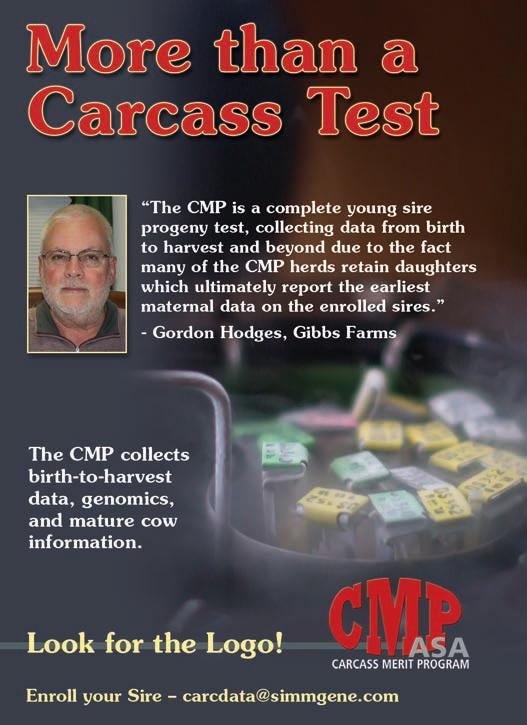
The United Kingdom formally requested approval to join the CPTPP in early 2021 and talks on the membership accession concluded in March, according to the group’s website. CPTPP members must vote to ratify the UK membership plan. The Canadian Cattle Association, Canadian Pork Council, and a variety of Canadian meat processors and exporters are asking the Canadian Parliament to vote against the proposal because of several British government rules that the groups say limit Canadian meat exports to the UK. British regulators currently refuse to allow beef treated with hormones from entering the country and reject Canada’s use of antimicrobials on carcasses in slaughterhouses, throwing off the balance of trade between the two nations. For example, Canada exported 657 metric tons of beef to the UK over 2021 and 2022, while British beef exports to Canada reached more than 7,000 metric tons in the same period.

Canada, Manitoba to Invest C$2.85M for Beef and Forage Programs
The governments of Canada and Manitoba plan to spend up to C$2.85 million over the next five years to support programs aimed at improving economic and environmental impacts of beef production.
The Manitoba Beef and Forage Initiatives (MBFI) is a nineyear-old collaboration between Manitoba beef producers, Ducks Unlimited Canada, and Manitoba Agriculture that uses research and demonstrations to help boost profitability and sustainability in the beef industry. The new funds will expand operational capacity by creating new positions to focus on technology, field operations, and outreach for beef producers, the Agriculture and Agri-Food Canada agency said in a news release.
The investment also will expand the Manitoba Advanced Grazing Systems Mentor Program, which connects producers to peers with experience in diverse grazing management systems.
Since 2018, MBFI has worked with 28 collaborators to deliver more than 40 innovative studies regarding beef production, including precision ranching, pasture rejuvenation, herd health, and forage variety testing, the release added. n
46 Register / October 2023
INTERNATIONAL

AI From a Different Angle
submitted by Dan Rieder
Artificial Insemination — well-known as “AI” to cattle producers — often leads to dramatic breed improvement through scientific utilization of superior genetics. However, there is another scientific development also known as AI that has recently emerged under the terminology of Artificial Intelligence.
Recently, my stepson Bill Becorest and his family from San Diego spent a couple of days visiting and amazed us with a vivid illustration of the recently developed Artificial Intelligence. To demonstrate its usefulness in his work, Bill asked me to provide a subject. I said: “Create a poem which combines Simmental cattle and ice cream.” Seconds later, starting from that simple sentence, the poem below was produced.
In fields of green, where Simmental cattle graze, their gentle presence, a sight to amaze.
With coats of gold and white, they roam so free, a breed of beauty, strong, and full of glee.
Their eyes so kind, their stature so grand, Simmental cattle, a majestic band.
Their milk, a gift, so rich and pure, from which sweet ice cream we can ensure.
Creamy and smooth, a delight to taste, ice cream made with love, no time to waste.
With flavors endless, from vanilla to mint, each spoonful a moment of pure bliss.
Simmental cattle and ice cream unite, nature’s wonders, a true delight.
From pastures green to cones held tight, ’tis a perfect pairing, a sweet delight.
Determining How Male Behaviors, Environment Affect Offspring in Livestock
by Kay Ledbetter, Bovine Veterinarian
Lacey Luense, PhD, spent the first ten years of her career using live animal models to understand the mechanisms of the sperm epigenome and its role in human disease and development. But now, she is taking her epigenetics research program in a new direction.
Luense is getting back to her first love — agriculture — as an assistant professor in the Texas A&M College of Agriculture and Life Sciences Department of Animal Science.
“I grew up in northwest Iowa in a rural area, and my family owns a steakhouse,” she said. “All my friends lived on farms, and I was in 4-H, so I grew up in an agricultural background. I knew from an early age that I wanted to study genetics and always thought I would go through graduate school and return to Iowa to apply my understanding of epigenetics to agricultural questions.”
But her path took her in a different direction. She earned her bachelor’s in biology at Augustana University in Sioux Falls, South Dakota, her master’s in genetics at Iowa State University, and her doctorate in molecular and integrative physiology at the University of Kansas Medical Center.
She then spent the next ten years, first as a postdoctoral fellow and then as a research associate, at the University of Pennsylvania School of Medicine.
“I ended up working with mice, which is a great system to better understand the basic mechanisms of genetics and epigenetics,” Luense said. “But I wanted to come back to the initial drive that I had while in high school and college to bring this area of study back around to answer agricultural questions. Texas A&M is a wonderful place to do that type of research. Obviously, the animal science program in the College of Agriculture and Life Sciences is extraordinarily strong.”
Epigenetics, Going Beyond DNA

The study of epigenetics identifies changes in gene function that are not due to mutations but rather how the DNA is packaged in the cell and turned on or off in the wrong conditions.
“This is often influenced by the environment, so things like diet, drugs, alcohol, heavy metals, toxicants,” she said. “All sorts of things can influence the epigenome or how our DNA is coiled in the cell and then turns genes on or off. And that all affects disease and development.”
For Luense, her research interest is with the germ line epigenome and how DNA in the sperm of cattle or humans, the paternal epigenome, can be influenced by the environment.
“We know the environment can affect the epigenome and absolutely alter how the DNA is packaged. I am extremely interested in using the basic mechanisms we are examining now and applying this knowledge to other questions such as climate change, drought, increasing temperatures, or health.”
She said the current hot temperatures will continue to affect ranchers throughout the state, and her goal is to understand how these environmental stressors impact reproduction.
“These are problems Texans need to understand to help their production operations,” she said. “By understanding the basic mechanism, looking for biomarkers, and understanding how this works, we can hopefully improve the fertility of bulls in the future.”
Luense said she is trying to understand how the environment can influence offspring or the early embryo. For instance, there are more long-term implications to look at, such as implantation — how does the paternal epigenetic system regulate the embryo to allow it to grow normally in the uterus? Does it affect longterm health and development, and potential disease for the offspring, whether children or livestock?
Scientists have understood a mother’s influence on offspring but are becoming more aware of how epigenetics within sperm can have a strong influence. Luense is interested in a deeper understanding of how male epigenetics impact progeny.
She said one of the important things she is excited about at Texas A&M and in animal science is using these technologies and knowledge to look at larger animals.
One of her first projects will look at the epigenome and sperm of cattle to understand fertility and how it relates to embryo development, long-term health and development of the offspring.
“I’m very much interested in how epigenetics affects dad and then how that affects their children,” Luense said.
Bringing Her Research Full Circle
While she is now concentrating on livestock, Luense said an exciting avenue would be to use her large animal research models to study human disease and development.
(Continued on page 50)
48 Register / October 2023 CUTTING EDGE

(Continued from page 48)
“I’m excited to have dual paths of translational value, to understand how the epigenome affects agricultural production and then utilize that for understanding human fertility and human development,” Luense said. “I would like to develop this into a research program where we can make impactful findings to multiple stakeholders on the animal production and human sides.”
She said there are similarities between bovine and human sperm and embryos, as well as more long-term development, and the discoveries in cattle can provide a better understanding of humans.
Luense will continue to use mice models in her research because they can help answer some questions quickly, but she hopes to answer more applied questions by studying cattle.
“It’s been a really nice opportunity to come full circle — my background, my training and then being able to come back and pull everything together in these different research areas,” Luense said. “We can study both agricultural questions, but then also gain an understanding of human health and disease.”
She has developed strong collaborative studies with experts at Texas A&M who have researched cattle, sheep, and other animals within different production systems.
Luense is also passionate about developing the next generation of scientists as a mentor for students. “That’s something I find really important, to mentor our students to become scientists, Extension agents, and teachers, and to help them get the training and encouragement they need.”
Strategies for Employing Whole Genome Sequencing and Its Benefits
 by Drovers
by Drovers
“The use of whole-genome sequencing at low-depth enables detection of rare variation, SNP discovery, CNV detection, and can eliminate the need for chip redesign and updates, and there is the potential for further cost reduction in the future” said Dr. Troy Rowan, University of Tennessee assistant professor, Knoxville.
Rowan delivered his presentation “Sequencing Strategies to Enhance the Next Generation of Genetic Evaluations” during the Beef Improvement Federation (BIF) Symposium July 4, in Calgary, Alberta, Canada.
The Big Questions
Rowan framed three big questions surrounding sequencing and imputation: Who do we sequence, how deep do we sequence, and how often do we update the reference and the imputed samples in the evaluation.
Relative to the first question, Rowan suggested, “We should be sequencing all sires with even moderate levels of AI usage.”
By sequencing AI sires the industry could generate an insurance policy, enabling faster mapping and management of genetic abnormalities when they arise. Sequencing AI sires also improves the quality of imputation throughout the population(s) that they are influential in. While widespread sequencing may have been out of reach in the past, the current cost of sequencing makes this tenable.
He also stated that multi-breed populations will need to make use of multi-breed reference populations for successful
imputation. He also pointed out that we need to move beyond only sequencing the most highly utilized animals; such a strategy may only sample a small portion of haplotypes that exist in the population.
Regarding depth of sequencing, Rowan suggested animals in the imputation reference set should be sequenced to at least ten times the coverage. He also mentioned that careful attention should be paid to downstream computational approaches to ensure that high quality genotype calls and phasing occurs.
Other Considerations
“The quality of information coming out cannot be better than the quality of information that went in — garbage in, garbage out,” Rowan said.
The reference population needs to be representative of the target population and be sequenced to a sufficient depth. Imputation accuracy, in terms of animals and SNPs, should be regularly evaluated to diagnose problems or shortcomings of the reference panel or imputation approach.
For breed associations and genetic evaluation service providers, the storage of genomes and imputed genotypes must also be considered. Moreover, the potential benefit, particularly in terms of improved accuracy of EPD (expected progeny difference), needs to be fully understood and quantified. n
COW SENSE
Ten questions designed to test your beef industry knowledge:
1. How soon after calving must a cow rebreed if she is to produce a calf on a regular 365-day interval?
2. A neutral pH is represented by what number?
3. Where in the body is vitamin A stored?
4. Where is the National Cattlemen’s Beef Association headquartered?

5. Who was the first President/Chairman of the American Simmental Association?
6. In an open cow, progesterone secretion ceases around how many days after heat?
7. What is the generally accepted minimum scrotal circumference for a yearling
Simmental bull undergoing a breeding soundness examination?
8. Which of the following would you expect to be highest in protein: wheat straw; alfalfa hay; oat hay; or ground ear corn?
9. For what purpose would a cannula be used in a university setting?
10. Name the two countries where most Fleckvieh cattle originate. n
Answers:
50 Register / October 2023 CUTTING
EDGE
1. Within 83 days; 2. Seven;
3. Liver; 4. Denver; 5. Jack Win-
niger of Meeteetse, WY;
6. Sixteen days;
7. Thirty-two centimeters;
8. Alfalfa hay; 9. research;
10. Germany and Austria.

Cow


Mark and Nolan Brunner 3553 Upland Rd. • Lost Springs, KS 785-466-6475 Kent 785-466-1129 Nolan 785-258-0173 Mark nolan@cowcampbeef.com
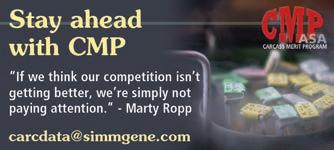


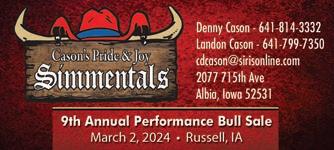








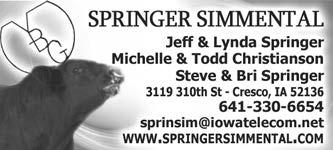

State Marketplace California Colorado Illinois Indiana Iowa Cattle Manager: Ben Lehman 563-920-0315 Owner: Jim Berry 6502 Rt. 84 South Hanover, IL 61041 815-297-5562 www.wildberryfarms.net Commercially Targeted Seedstock Red River Farms 13750 West 10th Avenue Blythe, CA 92225 Office: 760-922-2617 Bob Mullion: 760-861-8366 Michael Mullion: 760-464-3906 Simmental – SimAngus™ – Angus John & Barbara 812-546-5578 15633 E Jackson Rd. Hope, IN 47246 Dan, Jill, Luke & Chase 812-371-6881 Ben, Ashley, Gracie & Laynie 812-371-2926 Quality Red & Black Simmental Kansas DICKINSON SIMMENTAL AND ANGUS RANCH Kirk • 785-998-4401 (phone & fax) 2324 370th Ave. Gorham, Kansas 67640 www.dickinsonranch.com March 2024 52nd Annual Production Sale At the Ranch THE PERFORMANCE IS BRED IN – BEFORE THE BRAND GOES ON! 13703 Beaver Creek Rd • Atwood, KS 67730 785-626-3744 • drlyle@live.com www.dixsonfarms.com DX Dixson Farms, Inc. Carol Dixson, Kevin Dixson, & Lyle Dixson, D.V.M. Dixson Farms, Inc. JENSEN SIMMENTALS Steven A. Jensen • 913-636-2540 40532 John Brown Highway Osawatomie, KS 66064 jensensimmentals@gmail.com www.jensensimmentals.com H In our 6th decade breeding Simmental cattle. 52 Register / October 2023 Joe & Kim Mertz 785-458-9494 Abram & Dani Mertz 785-456-3986 7160 Zeandale Road Manhattan, KS 66502 www.rivercreekfarms.com 34th Annual “Built to Work” SimAngus Bull Sale, February 14, 2024
Spring
Spring Turn-Out
27, 2024
Camp Ranch Kent,
Bull Sale – Friday, January 20, 2024
Sale – Friday, April






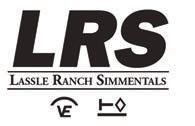








Nebraska “Red and Black, Polled, Pigmented Simmentals” FORSTER FARMS Verlouis Forster Family 74096 Road 434 Smithfield, NE 68976-1039 Ph 308-472-5036 Verlouis 308-991-2208 Alan Cell Email: alan_forster@hotmail.com Just 20 minutes off I-80 Black Simmental Bulls & Females Purebred to Percentage J & C SIMMENTALS J C J C Jay & Kim Volk Clark & Leslie Volk Bob & Jeanette Volk 20604 US Hwy 30 • Arlington, NE 68002 volkjk@aol.com • www.jandcsimmentals.com J&C Annual Bull Sale –January 27, 2024 Jay 402-720-7596 • Clark 402-720-3323
LDr. Lynn Aggen Office: 507-886-6321 Mobile: 507-421-3813 Home: 507-886-4016 Matt Aggen Mobile: 701-866-3544 Home: 507-772-4522 Email: mattaggen@hotmail.com Harmony, MN 55939 www.oakmfarm.com Performance with Quality Prickly Pear Simmental Ranch Troy Wheeler, Cattle Manager: 406-949-1754 Gary Burnham: 406-439-2360 2515 Canyon Ferry Road • Helena, MT 59602 ASA No. 174 E-mail: ppsranch@gmail.com Birthplace of the first Polled Black Simmental Bull Made in Montana Sale • February 3, 2024 Clay & Marianne Lassle Sarah & Ryan Thorson 42 Road 245 Glendive, Montana Clay: 406.486.5584 Ryan: 406.694.3722 lrsbeef@midrivers.com lassleranchsimmentals.com
Minnesota Missouri
Cleo Fields 417-399-7124 Jeff Reed 417-399-1241 Forrest & Charlotte Lucas, Owners 26511 County Rd. 50 Cross Timbers, MO 65634 Office 417-998-6512 LUCAS CATTLE CO. www.lucascattlecompany.com Visitors Always Welcome Registered Simmentals, SimAngusTM & Angus Cattle October 2023 / Register 53 JD Anderson Arapahoe, NE 308-962-6146 powerlinegenetics.com powerlinegenetics@gmail.com Montana Bill Begger 482 Custer Trail Road Wibaux, MT 59353 Bill: 406-796-2326 John: 406-795-9914 darbegger@gmail.com Wednesday, February 7, 2024 • at the ranch, Wibaux, MT 180 Black Simmental, SimAngusTM and Angus Bulls to Sell 402-641-2936 Cell Nick and Andrea 303 Northern Heights Drive • Seward, NE 68434 sloupsimmentals@gmail.com • sloupsimmentals.com Join us at the Farm, October 21, 2023 for our 29th Annual Production Sale.
J
Darby & Annette Line 35355 Arrow Road • Miller, NE 68858 308-627-5085 Darby Cell www.trianglejranch.com Bull Sale last Sunday in January and Female Sale first Sunday in November.
Triangle
Ranch

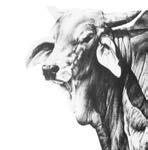








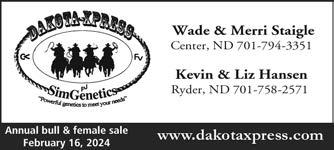



(Continued from page 00)
BRINK FLECKVIEH 23098 Gunder Rd • Elkader, IA 52043 Jerry: 563-245-2048 • Preston: 563-880-2075 jbrink@alpinecom.net Visit our website: www.brinkgenetics.com
Carolina 8800 Row-Cab Line Rd. • Rockwell, NC 28138 704-279-3128 • 704-202-6171 Cell E-mail: myram@morrisonfarm.com www.morrisonfarm.com REGISTERED SIMMENTAL F-1 REPLACEMENTS REGISTERED BRAHMANS MYRA NEAL MORRISON North Dakota ( ) JF Western Cattle Source Jock & Brenda Beeson 100 Wohlers Drive Crawford, NE 69339 308-665-1111 (home) 308-430-2117 (mobile) 308-430-0668 (mobile) Email:wcsbeeson@bbc.net JENSEN SIMMENTALS Steven A. Jensen • 913-636-2540 40532 John Brown Highway Osawatomie, KS 66064 jensensimmentals@gmail.com www.jensensimmentals.com H In our 6th decade breeding Simmental cattle. Scott Riddle Fred Schuetze 817-894-0563 2649 Pear Orchard Road Granbury, Texas 76048 Website: simmentalsoftexas.com • Email: sotsimmentals@yahoo.com Fleckvieh & Fleckvieh-Based Simmentals • SimAngusTM • Simbrah 54 Register / October 2023 QBVJT Power by Design Quandt Brothers 701-710-0080 VJT Ranch 701-710-0843 Oakes, ND Sale February 20, 2024 5606 57th St. NE Leeds, ND 58346 Phone 701-466-2800 Erika 406-581-1188 erika.kenner@gmail.com Fax 701-466-2769 Roger, Jeanette, & Erika Kenner www.kennersimmental.com KENNER KENNER SIMMENTALS SIMMENTAL CATTLE 6322 Highway 35 Adams, North Dakota 58210 Joe: 701-331-0344 • Mark: 701-331-3055 Annual Production Sale • February 9, 2024 “BBS” THE MARK OF ...QUALITY... Nebraska cont. Claye and Michelle Kaelberer and Family 4215 County Road 85 • New Salem, ND 58563 701-220-3124 (cell) • 701-843-8342 (home) Edge of the West Bull and Female Production Sale each February Kaelberer Simmentals 5065 125th Ave. NE • Dahlen, ND 58224 tellings@polarcomm.com • www.ellingsonsimmentals.com Terry Ellingson & Family Annual Production Sale, January 26, 2024 Phone: 701-384-6225 Cell: 701-741-3045 Terry and Cathy Schlenker Family 7649 49th Street SE Montpelier, ND 58742 701-489-3583 (home) 701-320-2171 (cell) www.wilkinsonfarmssimmentals.com Wilkinson Farms Simmentals 39th Annual “Carrying On” The Genetic Explosion Bull Sale! Friday, February 9, 2024 • At The Ranch, Lehr, ND Shanon & Gabe Erbele Lehr, ND S 701-527-5885 • G 701-426-9445 gserbele@hotmail.com Kevin & Lynette Thompson Almont, ND H 701-843-8454 • K 701-391-1631 kevinandlynette@westriv.com www.tntsimmentals.com DVAuction.com TNT Simmental Ranch facebook.com/tntsimmentalranch Ohio
State Marketplace North American Fullblood Breeders
North
Benda Simmentals



Jim and Jay Benda
26106 366th Ave. Kimball, SD 57355 605-778-6703

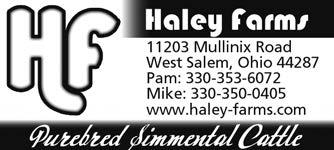
Jim: 605-730-6703 (Cell) Jay: 605-730-0215 (Cell) bendaranch@midstatesd.net



Black and Red Breeding Stock
Dawn – 605-680-4224
Kari – 605-680-4386


Home – 605-894-4464
Simmental Cattle – Club Calves
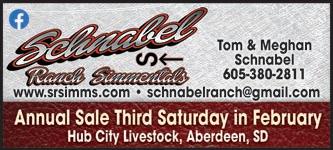



Christensen H Dunsmore
3C Christensen Ranch
John Christensen, Cam & Tyler Fagerhaug
37273 216th Street • Wessington, SD 57381
605-458-2218 home • 605-458-2231 fax

605-350-1278 cell




458-350-2018 Cam
Annual Production Sale
March 15, 2024 • Wessington, SD
NLC Simmental Ranch

Rick & Nalani L. Christensen
Dunsmore & NaLea, Chase & Swayzee 21830 372nd Ave • Wessington, SD 57381
605-458-2425 • 605-354-7523 cell
605-350-5216 cell
R&R Cattle Company



3 C


NLC

Oklahoma Willis Simmentals
Simmentals Bobby 580-276-2781 (ph. & fax) 10 miles east on Hwy. 32, 1/4 mile north on Enville Road. Jon 580-795-4601 5759 Enville Road Marietta OK 73448 willissimmentals@arbuckleonline.com Quality Simmental Breeding Cattle Gary and Cindy Updyke Checotah, OK • 918-473-6831 (H) • 918-843-3193 (C) garyupdyke38@gmail.com www.facebook.com/UpdykeSimmentals PO Box 127 Harrod, OH 45850 419-648-9196 (home) 419-648-9967 (office) 419-230-8675 (cell) Troy Jones & Randy Jones jonesshowcattle@hotmail.com • jonesshowcattle.com
Clay Ekstrum 605-778-6185 (H) 605-730-1511 (C) John Ekstrum 605-778-6414 South Dakota’s Source for Outcross Performance Simmentals! – Specializing in Hard to Find Red Breeding Stock – 36220 257th St., Kimball, SD 57355 clayekstrum@midstatesd.net • ekstrumsimmentals.com Harley, Dawn and Kari Cable 2344 Rocky Road • Pukwana, SD hdcable@midstatesd.net Harley – 605-680-0845
Willis
South Dakota
11913 342nd Ave • Hosmer, SD 57448 605-283-2662 • flittiesimm@valleytel.net Kerry, Justin, and Travis Hart 605-252-2065 (Kerry) 605-216-6469 (Justin) 605-252-0894 (Travis) 4hooves@nvc.net www.hartsimmentals.com 10904 387th Avenue Frederick, SD 57441 Steve & Cathy Eichacker 605-425-2391 or 605-421-1152 email: es@triotel.net 25446 445th Ave Salem, SD 57058 Annual Bull Sale • March 1, 2024 October 2023 / Register 55 Steve & Elaine Reimer & Family 25657 345th Avenue Chamberlain, SD 57325 Phone: 605-234-6111 Email: rrcattle@midstatesd.net
TRAXINGER SIMMENTAL Mike and Terri Traxinger 11176 – 406th Avenue Houghton, SD 57449 Home: 605.885.6347 Mike’s cell: 605.294.7227 mtrax@nvc.net www.traxinger.com Reds, Blacks • Bulls and Females Private Treaty Sales Tennessee








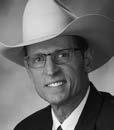



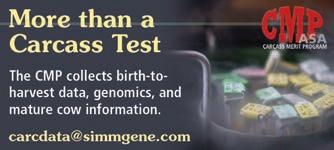

Washington Texas Mike & Paulette Forman 509-968-4800 Robb & Debbie Forman 509-201-0775 2451 Number 81 Rd. Ellensburg, WA 98926 www.trinityfarms.info • Email: trinity@fairpoint.net Angus SimAngusTM Simmental Trinity Farms Generations of Excellence Sale...first Saturday in March Jud and Margie Flowers 12111 N. Bryan Road • Mission, TX 78573-7432 956-207-2087 email: judf@lonestarcitrus.com “No Nonsense” Simbrah Cattle Joe & Beth Mercer 327 CR 459 Lott, TX 76656 Cell: 956-802-6995 Home, Office: 254-984-2225 bethmercer1974@gmail.com www.filegoniacattle.com Z Z FILEGONIA CATTLE COMPANY CATTLE COMPANY Simbrah, SimAngusTM HT, SimAngusTM & Simmental Jane and Bill Travis billtravis@simbrah.com www.simbrah.com 9876 PLANO RD. DALLAS, TX 75238 Cell: 214-850-6308 Pine Ridge Ranch Pine Ridge Ranch Pine Ridge Ranch ATHENS, TX LLC 56 Register / October 2023 4812 McBreyer Pl Fort Worth, Texas 76244-6083 817-562-8980 Office • 817-562-8981 Fax 815-762-2641 Cell jim@jamesfbessler.com www.jamesfbessler.com Insurance Semen Available on Today’s Hottest AI Sires 573-641-5270 www.cattlevisions.com Genetics Livestock Services ROGER JACOBS Auctioneer P.O. Box 270 Shepherd, MT 59079 406-373-6124 Home 406-698-7686 Cell 406-373-7387 Fax auctions@jacobslivestock.com Auctioneers and Marketing MIKE WILLIAMS, Auctioneer 18130 Brush Creek Road Higginsville, MO 64037 PH: 660-584-5210 • Cell: 816-797-5450 Email: mwauctions@ctcis.net WILLIAMS WILLIAMS L L aanndd && C C aattttllee A A uuccttiioonn C C oo.. State Marketplace

NEW MEMBERS
CANADA
Jon-Ern Farms Limited
8920 Bisnett Line
Blenheim, Ontario N0P IA0
ALABAMA
Hodnett 5 Farm
2070 Drake Rd
Wadley, AL 36276
ARKANSAS
Romance Valley
Cattle Company
431 Romance Rd
Romance, AR 72136
CALI FORNIA
Bar 28 Ranch
20415 Road 168
Strathmore, CA 93267
COLORADO
Rich Kanzler
36259 WCR 22
Roggen, CO 80652
FLORIDA
Larry Coogle
1520 S River Rd
Spring Hill, FL 34609
Hickory Ranch Cattle
6979 Old Federal Rd
Quincy, FL 32351
RLP Ranch LLC
895 Case Rd
LaBelle, FL 33935
Blain Peerson
5 D Street
St. Augustine Beach, FL 32080
GEORGIA
WF Farm LLC
377 Harris Rd
Lexington, GA 30648
Twisted Spur Cattle Co
2050 Jeff Davis Rd
Thomaston, GA 30286
IDAHO
Hinterland Ranch LLC
897 Katka Rd
Bonners Ferry, ID 83805
ILLINOIS
Kilee Smith
1730 State Hwy 123
Alexander, IL 62601
Adam Emery Farms
19333 Tiels Rd
Carlinville, IL 62626
INDIANA
Kolb Livestock 3933 W 241st
Sheridan, IN 46069
Paetzel Farms Show Cattle
607 S Prairie St
Brookston, IN 47923
IOWA
Kortney Brosamle
1670 210th St
Denison, IA 51442
Nisha Valley Farms
1896 225th Ln
Hamlin, IA 50117
Greg & Kim Van Zee
1166 6th Ave Cir Ne
Sioux Center, IA 51250
James Schooley
13942 Yam Blvd
Selma, IA 52588
Harman Farms 23417 Sycamore Rd
Neola, IA 51559
KANSAS
Tommy Taul 3326 Trevelyan Ave
Manhattan, KS 66503
Morton Family Farms 11565 Clear Creek Rd
Westmoreland, KS 66549
KENTUCKY
Nathan Whelan 1785 New State Rd
Webster, KY 40176
LOUISIANA
T & H Polled Hereford 529 Tramel Rd
Dry Creek, LA 70637
MICHIGAN
Bartlett Farms 1876 Bartlett Rd
Sterling, MI 48659
MINNESOTA
Brandon Gruis 18611 290th St
Adrian, MN 56110
James Stromberg 409 255th Ave
Granada, MN 56039
MISSISSIPPI
Wise Farms 2849 Summit Dr SW
Bogue Chitto, MS 39629
Holland Cattle Company
2759 A Good Hope Rd
Batesville, MS 38606
Lees Cattle Company
27035 Weber Rd
Perkinston, MS 39573
Royal Flush Livestock Services
6195 Craigsprings Rd
Sturgis, MS 39769
MISSOURI
Jarrod Simpson 1551 CR 6160
Salem, MO 65560
MONTANA
Seder Cortney L 1511 Patricia Ln
Billings, MT 59102
NEBRASKA
Frenzen Cattle Company 104 4th St
Silver Creek, NE 68663
NORTH CAROLINA
Kayla Vanhoy
5101 Crater Rd
Hamptonville, NC 27020
Bradley Sigmon 5051 Dobbins Rd
Crouse, NC 28033
OHIO
Kevin Pletcher
8751 Foraker Rd
Crooksville, OH 43731
Harder Farms
3259 S Four Mile House Rd
Oak Harbor, OH 43449
Tidricks Cattle
19933 Cadiz Rd
Quaker City, OH 43773
Sharms Farm Jay Shafer Family
13910 Thorn Township Rd 37
Thornville, OH 43076
Stanley Knox 2049 Twp Rd 45 NE
Somerset, OH 43783
OKLAHOMA
Paisley Cattle Company PO Box 702
Locust Grove, OK 74352
Lovett Farms
4805 S Preston Rd
Tishomingo, OK 73460
OREGON
Madison Cox
1881 Brophy Rd
Eagle Point, OR 97524
Wild West Angus 24551 Hwy 140 E
Dairy, OR 97625
PENNSYLVANIA
The Patchwork Cowgirl PO Box 192 Blanchard, PA 16826
Mason Brehm 49 Racehorse Dr Jonestown, PA 17038
SOUTH DAKOTA
Tim Anderson 27124 435th Ave
Bridgewater, SD 57319

Bob Knoll 29883 412th Ave
Avon, SD 57315
TENNESSEE
Dylan Inman 766 TN Ave So
Parsons, TN 38363
TEXAS
Kimberly Emmons 635 Co Rd 623
Dayton, TX 77535
Smith & Sansom PO Box 330
Giddings, TX 78942
JCL- East PO Box 1045 Comfort, TX 78013
Lori Laube 13162 CR 550 Farmersville, TX 75442
VIRGINIA
WC Enterprises 621 Dabneys Rd
Raphine, VA 24472
WASHINGTON
Horizon Hay Co 2216 J Ronald Rd
Ellensburg, WA 98926
WEST VIRGINIA
Benner Michael T 1031 S Childs Rd
Kearneysville, WV 25430
WISCONSIN
Volden Cattle Company 2114 State St
La Crosse, WI 54601
Double J Ranch LLCLundy Farms PO Box 96
Medford, WI 54451 n
58 Register / October 2023

ASA FEE SCHEDULE
DNA Services (Contact ASA For Testing Kits)

(Must run with GGP-100K)
Arthogryposis Multiplex (AM)
Neuropathic Hydrocephalus (NH)
Developmental Duplication (DD)
Tibial Hemimelia (TH)
Pulmonary Hypoplasia with Anasarca (PHA)
Osteopetrosis (OS)
Contractural Arachnodactyly (CA)
(Individual defect tests can be ordered for $25.)
**Research Fee charged at $1.00/min – Includes but is not limited to: DNA re-checks to more than 2 additional parents, multi-sire pastures, excess time spent to confirm parentage, mis-identified samples, and samples arriving at lab without proper ASA paperwork.
***Prices are subject to change
Spring 2024 THE Enrollment — (dams calve January 1–June 30) —
Early enrollment open October 15 through December 15, 2023
Late enrollment available until February 15, 2024.
Fall 2024 THE Enrollment — (dams calve July 1–December 31) —
Early enrollment open April 15 through June 15, 2024.
Late enrollment available until August 15, 2024.
A re-enrollment fee of $35.00 applies to any dam that is removed from inventory and re-enters the herd at a later date.
A member who has dropped out of THE and wishes to return, may do so for the next enrollment season. Re-enrollment fee is $35 per animal (maximum of $350) plus enrollment fees. Non-THE registration fees will apply to the calendar year when a member did not participate in THE.
60 Register / October 2023 First Time Membership Fee: Adult First Time Membership Fee*. . . . . . . . . . . . . . $160 (Includes: $50 set-up fee and $110 ASF) Junior First Time Membership Fee*. . . . . . . . . . . . . . $40 Prefix Registration. . . . . . . . . . . . . . . . . . . . . . . . . . . . $10 *After January 1: $105 for Adults and $40 for Juniors Annual Service Fee (ASF)*: Adult Membership. . . . . . . . . . . . . . . . . . . . . . . . . . . $110 Junior Membership. . . . . . . . . . . . . . . . . . . . . . . . . . . $40 Fiscal year runs from July 1 – June 30 Registration Fees: Registration Fees enrolled in THE Enrolled in Option A . . . . . . . . . . . . . . . . . . . . No Charge Enrolled in Opt B or C <10 months. . . . . . . . . . . . . . $30 Enrolled in Opt B or C 10 months <15 months. . . $40 Enrolled in Opt B or C >15 months. . . . . . . . . . . . . $50
Enrollment American Simmental Association Fees Transfer Fees: First Transfer . . . . . . . . . . . . . . . . . . . . . . . . . . No Charge Subsequent Transfers Within 60 calendar days of sale. . . . . . . . . . . . . . . . $10 Over 60 calendar days after sale. . . . . . . . . . . . . . . $30 Additional Transactions: Priority Processing (not including shipping or mailing) . . . . . . . . . . . . . . . . . . . $50 Corrections. . . . . . . . . . . . . . . . . . . . . . . . . . . . . . . . . . . $5 Registration Foreign/Foundation Fees: Register Foundation Cow . . . . . . . . . . . . . . . . . . . . . . . $5 Register Foundation Bull . . . . . . . . . . . . . . . . . . . . . . $25 Registration Fees not enrolled in THE: Non-THE <10 months . . . . . . . . . . . . . . . . . . . . . . . . $42 Non-THE 10 months <15 months . . . . . . . . . . . . . . $52 Non-THE >15 months . . . . . . . . . . . . . . . . . . . . . . . . $62 Option A (TR) Option B (SR) Option C Option D (CM) Early Enrollment $15.00 FREE $7.50 $500/herd *Late Enrollment $16.00 $1.00 $8.50 $500/herd *Late enrollment fees DNA Collector Fees: Allflex TSU - $20.00 (box of 10) • Allflex Applicator - $40.00 • Blood Cards - $1.00 ea. (processing fee) Hair Cards - $5.00 ea. (processing fee) • Sample Pull Fee – $2.00 ea.
THE
Genomic Tests: *GGP-100K . . . . . . . . . . . . . . . . . . . . . . . . . . . . . . . . . . . $50 GGP-uLD . . . . . . . . . . . . . . . . . . . . . . . . . . . . . . . . . . . . . $33 *Add-on tests available Stand Alone Add-on SNP Parental Verification . . . . . . . . . . . . . . . $18 Free STR Parental Verification. . . . . . . . . . . . . . . . $33 $15 Coat Color. . . . . . . . . . . . . . . . . . . . . . . . . . . $22 $9 Red Charlie. . . . . . . . . . . . . . . . . . . . . . . . . . . $26 $16 Horned/Polled. . . . . . . . . . . . . . . . . . . . . . . . $33 $22 PMel (Diluter). . . . . . . . . . . . . . . . . . . . . . . . $22 $2 Oculocutaneous Hypopigmentation (OH). . $25 $16 BVD PI. . . . . . . . . . . . . . . . . . . . . . . . . . . . . . . . $5 Semen Sample Processing Fee. . . . . . . . . $7.20 Genetic Conditions Panel. . . . . . . . . . . . . . . . $25

OCTOBER
NOVEMBER
2–4 Boyle Ranch’s Red, White and Beautiful Fleckvieh Female Online Sale — www.auctions.boyleranchfleckvieh.com (pg. 10)
4 27th Annual Southern Showcase — Rome, GA
4 Cason’s Pride & Joy Simmentals’ Maternally Inspired Female Sale — Russell, IA
4 Irvine Ranch’s 19th Annual Production Sale — Manhattan, KS
4 Missouri Simmental Fall Harvest Sale — Springfield, MO

4 Pollington Bred For Success Sale — St. Johns, MI (pg. 59)
5 Triangle J Ranch’s Female Sale — Miller, NE (pg. 53) 11 Gibbs Farms’ 18th Annual Bull and Replacement Female Sale — Ranburne, AL

62 Register / October 2023
Mississippi State Elite Heifer and Bull Sale — Jackson, MS 7 Factory Direct Sale — West Lafayette, IN 7 Lucas Cattle Company’s Fall Bull Sale — Cross Timbers, MO 8 Our Vision, Your Future Sale — Chalmers, IN 9 Burlap and Barbed Wire Female Sale, Vol. VII — Clay Center, KS 10 Coleman Angus’ Complete Fall Herd Dispersal Sale — Charlo, MT 10–11 RA Brown Ranch's 49th Annual Sale — Throckmorton, TX 14 C&C Farms’ Clear Vision Fall Production Sale — Winder, GA 14 Fred Smith Company’s Extra Effort Sale — Clayton, NC 14 Trinity Farms’ Fall Female Sale — Ellensburg, WA 15 Houck Rock Creek Ranch’s Private Treaty Sale — Allen, KS 21 The Black Label — Grandview, TX 21 Blackjack and Guests Female Production Sale — Seminole, OK 21 Ferguson Show Cattle’s Annual Rare Vintage Production Sale — Jefferson, OH 21 Little Creek Cattle’s Magnolia Classic — Starkville, MS 21 New Day Genetics’ Fall Bull Sale — Salem, MO 21 New Direction Sale — Seward, NE (pgs. 53, 61) 27 29th Annual Hokie Harvest Sale — Blacksburg, VA 27 Yon Family Farms’ Fall Female Sale — Ridge Spring, SC 28 7P Ranch’s 48th Annual Production Sale — Winona, TX (pg. 7) 28 Clear Choice Female Sale — Milan, IN (pgs. 52, 65) 28 Deep South Genetics — Troy, AL 28 Pennsylvania Simmental’s Fall Classic Sale — Waynesburg, PA 28 Red Hill Farms’ Bulls and Females of Fall Sale IX — Lafayette, TN 28 Yon Family Farms’ Fall Bull Sale — Ridge Spring, SC 29 Red River Farms’ Ladies of the Lonestar Annual Production Sale — Grand Saline, TX
6
18 Callaway
AffordaBULL
18 Next Step Cattle Company — Livingston,
18 Stanley Martins Farms’ Fleckvieh Female Sale — Decorah, IA (pg. 6) 18 Strickland Cattle’s Bull and Female Sale — Glennville, GA 18 Yardley Cattle Company’s Focus on the Female Sale — Beaver, UT (pg. 13) 20 Bichler Simmentals’ Production Sale — Linton, ND 24 Divas and Donors – The Exclusive — Dixon, IL 25 Great Lakes Beef Connection Bred Female Sale — Claire, MI 25 Stavick Simmental’s Queen of the Prairie Female Sale — Veblen, SD 25 Trennepohl Farms’ Right By Design Sale — Middletown, IN
2 Jewels of the Northland — Clara City, MN 2 T-Heart Ranch and L-Cross Ranch High Altitude Female Sale — La Garita, CO 2 Western Choice Simmental Sale — Billings, MT 2 Wilson SimAngus Dispersal Sale — Billings, MT 8 JS Simmentals’ Midwest Made Elite Female Sale — Prairie City, IA 9 NDSA Classic Sale — Mandan, ND 9 North Alabama Bull Evaluation Sale — Cullman, AL 10 Trauernicht Simmentals’ LHT Female Sale — Wymore, NE 15 Buck Creek Ranch’s Grand Event — Yale, OK 16 South Dakota Source Sale — Mitchell, SD 22 Bata Brothers Complete Herd Dispersal (Online) — Adams, ND 28 St. Nick’s Eggstravaganza Online Sale — www.dponlinesales.com
Cattle Company’s
Sale — Hogansville, GA
AL
DECEMBER
DATE BOOK
JANUARY 2024
12 Diamond Bar S Bull Sale — Great Falls, MT (pg. 53)
16 Powerline Genetics’ Arapahoe Sale — Arapahoe, NE
20 Cow Camp Ranch’s Annual Spring Sale — Lost Springs, KS (pg. 52)
23 Franzen Simmentals’ Production Sale — Lehigh, NE
26 Double J Farms’ 50th Annual Bull and Female Sale — Garretson, SD (pg. 55)
26 Ellingson Simmentals’ Annual Production Sale — Dahlen, ND
27 J&C Simmentals’ Annual Bull Sale — Arlington, NE (pg. 53)
28 Triangle J Ranch’s Bull Sale — Miller, NE (pg. 53)
29 APEX Cattle’s Annual Heterosis Headquarters Bull, Bred Heifer and Fall Pair Sale — Dannebrog, NE
FEBRUARY 2024
1 Stavick Simmental’s Annual Sale — Veblen, ND (pg. 55)
2 Kunkel Simmentals’ Annual Production Sale — New Salem, ND
3 Klain Simmental Ranch’s 42nd Annual Production Sale — Ruso, ND
3 Springer Simmentals Sale of Value-Based Genetics — Decorah, IA
3 Prickly Pear Simmental Ranch’s Bull Sale — Helena, MT (pg. 53)
5 44th Annual Gateway “Breeding Value” Bull Sale — Glendive, MT
5 Long’s Simmentals’ 4th Annual Production Sale — Creston, IA
7 Begger’s Diamond V Big Sky Genetic Source Bull Sale — Wibaux, MT (pg. 53)
8 Houck Rock Creek Ranch’s Private Treaty Spring Bull Sale — Allen, KS
8 Lassle Ranch Simmentals 31st Annual Production Sale — Glendive, MT
9 Bata Brothers/Bell Family Annual Joint Simmental Bull and Female Sale — Rugby, ND (pg. 54)
9 TNT
Annual “Carrying On” the Explosive Difference Sale — Lehr, ND (pg. 54)
10 CK and Wager Cattle’s 7th Annual Production Sale — Highmore, SD
10 Dixie National Simmental Sale — Jackson, MS
10 Kenner Simmentals’ 28th Annual Production Sale — Leeds, ND
10 Rydeen Farms’ 26th Annual “Vision” Sale — Clearbrook, MN
12 Dakota Power Bull and Female Sale — Hannaford, ND
12 Nelson Livestock Company Production Sale — Wibaux, MT
13 Edge of the West Bull and Female Sale — Mandan, ND
14 Jackpot Cattle Company’s Private Treaty Bull and Heifer Sale — Miller, SD
14 River Creek Farms’ 34th Annual Production Sale — Manhattan, KS (pg. 52)
14 Traxinger Simmental’s Annual Bull Sale — Houghton, SD
16 Dakota Xpress’ Annual Bull and Female Sale — Mandan, ND (pg. 54)
16 R&R Cattle Company’s Annual Production Sale — Chamberlain, SD
16 Sandy Acres Simmental’s Bull Sale — Creighton, NE (pg. 53)
17 7P Ranch’s 30th Annual Spring Bull and Female Sale — Winona, TX
17 Flittie Simmental/Schnabel Ranch Simmentals/Lazy J Bar Ranch’s Joint Production Sale — Aberdeen, SD (pg. 55)
17 K-LER Cattle’s Annual Production Sale — St. Charles, MN (pg. 53)
17 Rhodes Angus Open House and Bid Off Bull and Female Sale — Carlinville, IL
17 Yon Family Farms’ Spring Bull and Female Sale — Ridge Spring, SC
18 Trauernicht Simmentals’ LHT Bull Sale — Wymore, NE
19 Bulls of the Big Sky — Billings, MT (pg. 53)
20 Quandt Brothers Cattle Company 12th Annual Bull Sale — Oakes, ND (pg. 54)
21 Hart Simmentals’ Power Bull Sale — Frederick, SD
22 Haven Hill Simmentals’ Bull Sale — Milan, IL
22 Illinois Performance Tested Bull Sale — Springfield, IL
23 Multi-Breed Simmental Sale — Springfield, IL
24 Cattle Connect at Franzen Simmentals — Leigh, NE
24 Emmons Ranch Sale — Olive, MT
24–3/2 Hofmann Simmental Farms’ “Buy Your Way Bull Sale” — Clay Center, KS
28 C Diamond Simmentals’ Annual Production Sale — Dawson, ND
MARCH 2024
1 Eichacker Simmentals’ Annual Bull Sale — Salem, SD (pg. 55)
2 Cason’s Pride & Joy Bull Sale — Russell, IA (pg. 52)
2 Powerline Genetics’ PAP Tested Bull Sale — Castle Dale, UT
2 Trinity Farms’ Generations of Excellence Sale — Ellensburg, WA (pg. 56)
4 Hill’s Ranch Production Sale — Stanford, MT
4 Rincker Simmentals’ Sweet 16 Bull and Female Sale — www.sconlinesales.com
4 S/M Fleckvieh Cattle’s Private Treaty Bid-Off — Garretson, SD
5 Doll Simmental Ranch 44th Annual Production Sale — Mandan, ND (pg. 54)
6 Klein Ranch’s Heart of the Herd Sale — Atwood, KS
7 Cattleman’s Kind Bull Sale — San Saba, TX
7 Keller Broken Heart Ranch Annual Production Sale — Mandan, ND (pg. 54)
9 24th Annual Gonsior Simmentals’ In the Heartland Sale — Fullerton, NE
9 Carcass Performance Partners Bull and Female Sale — Lucedale, MS
9 TN Beef Agribition — Lebanon, TN
9 Yardley Cattle Company’s 51st Annual Bull Sale — Beaver, UT
12 Powerline Genetics’ March Edition Bull Sale — Arapahoe, NE
13 RA Brown Ranch’s Spring Bull Sale — Throckmorton, TX
14 B&B Simmental Cattle’s Annual Sale — Gregory, SD
15 3C Christensen Ranch and NLC Simmental Ranch’s Annual Production Sale — Wessington, SD (pg. 55)
15 Black Summit Bull Sale — Powell, WY
15 Eastern Spring Classic Simmental Sale — Columbus, OH
16 Colorado Select Bull Sale — Fort Collins, CO
16 Lechleiter 36th Annual Bull Sale — Loma, CO
16 Red Hill Farms’ More Than A Bull Sale XIX — Lafayette, TN
18 Bridle Bit Simmentals All Terrain Bull Sale — Walsh, CO (pg. 52)
23 T Heart Ranch High Altitude Bull Sale — La Garita, CO (pg. 52)
24 Western Cattle Source’s Bull Sale — Crawford, NE
27 Diamond H Ranch’s Annual Production Sale — La Crosse, KS (pg. 52)
APRIL 2024
1 Henry’s Fork Cattle Company’s Private Treaty Bulls for Sale — Rexburg, ID
4 Midland Bull Test — Columbus, MT
5 Kansas Bull Test Sale — Green, KS
6 Belles and Bulls of the Bluegrass — Lexington, KY
6 Big Country Genetics Sale — Cody, WY
6 McDonald Farms’ Annual “Pick of the Pen” Bull Sale — Blacksburg, VA
6 The Gathering at Shoal Creek — Excelsior Springs, MO n
October 2023 / Register 63
9 Bred For Balance Sale — Starbuck, MN
Simmental’s 39th
RATES & POLICIES
Serving as American Simmental Association’s (ASA) official publication, the Register is mailed nine times annually, has a circulation of 5,500+, and is focused primarily on ASA’s paid membership.


the Register is an 81/8 x 107/8 inch glossy, full-color publication that provides a direct and consistent line of communication to the ASA membership.
Ad Sales Staff
For All Your Advertising Needs
Space and four-color rates for the Register:
•
Subscriptions
•
•
the Register Deadlines for Publication:
A non-refundable fee of $50.00 will be assessed if a client does not meet deadlines or if the client commits to advertising and cancels after the deadline or if the ad must be dropped to ensure on time publication.
Advertising materials (including photos) must be in the Register office by the dates listed above. the Register, which mails by periodicals rate, assumes no responsibility for actual receipt date.
Design Charges
Advertising rates are for camera-ready ads only. Additional design charges will apply to any ad that is designed by ASA Publication, Inc.
Layouts & Proofs
Every effort will be made to provide proofs on all ads — if all ad material arrive in the Register office prior to the deadline and a correct email address or fax number is provided.
Advertising Content
the Register and its staff assume no responsibility or obligation to verify the accuracy and truthfulness of advertising copy submitted to the Register. However, the Register reserves the right to reject any advertising copy or photo which the Register deems unsuitable for publication for any reason, including copy

or photographs which are false or misleading. the Register assumes no responsibility for the accuracy and truthfulness of submitted print ready ads. Advertisers shall indemnify and hold harmless the Register for any claims concerning advertising content as submitted. Advertising containing pedigrees or statements regarding performance must conform to records kept by the American Simmental Association. Copy deviating from official records may be changed as necessary without advertiser consent.
Editorial Policy
Opinions expressed are the writers’ and not necessarily those of the Register. Photographs are welcome, but no responsibility is assumed for material while in transit or while in the office.
Terms
All accounts are due and payable when invoiced. Interest charges of 1.5 percent per month (18 percent APR) will be added to accounts 30 days past due. If an account becomes 60 days delinquent, all ASA Publication, Inc. work may be suspended until full payment is made. After review by the ASA Executive Committee, ASA privileges may be denied to those with accounts over 90 days delinquent.
64 Register / October 2023
Nancy Chesterfield 406-587-2778 nchesterfield@simmgene.com Send all ad materials to: register@simmgene.com or Fax: 406-587-8853 Rebecca Price 406-587-2778 rprice@simmgene.com Space Rates Non-Contract 5X Contract 9X Contract Four Color 1 page $770 $730 $700 $300 2/3 page $660 $630 $600 $200 1/2 page $440 $420 $400 $150 1/3 page $330 $315 $300 $100 1/4 page $220 $210 $200 $75 1/8 page $150 $50 3-inch mini $100 $30 2-inch mini $85 $15 2-inch card $700/year, 9 insertion $135 1-inch card $390/year, 9 insertions $90 Classified Ads $.60/word, $12.00 minimum, must be prepaid
One Genetics Way Bozeman, Montana 59718 USA 406-587-2778 • Fax 406-587-8853 register@simmgene.com
Domestic $50/year
First Class
$100/year
All International
(US) ASA Publication, Inc
$150/year
Issue Sales Close Ad Materials Camera Ready Mail Date November ’23 Oct 3 Oct 6 Oct 19 Nov 2 Dec ’23/Jan ’24 Nov 15 Nov 17 Dec 5 Dec 19 February ’24 Dec 29 Jan 4 Jan 17 Feb 1 March ’24 Feb 1 Feb 7 Feb 16 March 5 April ’24 Feb 29 March 5 March 19 April 2 May/June ’24 April 4 April 9 April 19 May 7 July/August ’24 June 24 June 27 July 10 July 25 September ’24 August 1 August 6 August 16 Sept 3


66 Register / October 2023 3C Christensen Ranch. . . . . . . . . . . . . 55 701x® . . . . . . . . . . . . . . . . . . . . . . . . . . . 5 701x® Autonomous Rancher. . . . . . . . 5 7P Ranch. . . . . . . . . . . . . . . . . . . . . . . . 7 ABS® Global Inc.. . . . . . . . . . . . . . . . 1, 5 Allflex® . . . . . . . . . . . . . . . . . . . . . . . . . . 2 Allied Genetic Resources. . . . . . . . . . . . 7 American Brahman Breeders Association. . . . . . . . . . . . 7 American Live Stock Inc.. . . . . . . . . . . 56 American Royal. . . . . . . . . . . . . . . 26, 27 American Simmental Association. . . . . . . . IFC, 4, 7, 14, 15, 18, 19, 25, 26, 27, 29, 33, 35, 39, 43, 45, 47, 51 Arrow H Simmentals. . . . . . . . . . . . . . 61 ASA Performance Advocate. . . . . . . . 53 ASA Publication, Inc.. . 11, 37, 44, 49, 57 Bata Bros.. . . . . . . . . . . . . . . . . . . . . . . 54 Becker, Larry. . . . . . . . . . . . . . . . . . . . 18 Begger’s Diamond V. . . . . . . . . . . . . . 53 Benda Simmentals, Jim. . . . . . . . . . . . 55 Beshears Simmentals. . . . . . . . . . . . . 65 Bessler Inc, James F. . . . . . . . . . . . . . . 56 Boyle Ranch. . . . . . . . . . . . . . . . . . . . . 10 Bred for Success. . . . . . . . . . . . . . . . . 59 Bridle Bit Simmentals. . . . . . . . . . . . . 52 Brink Fleckvieh. . . . . . . . . . . . . . . . . . . 54 Brush Country Bulls. . . . . . . . . . . . . . . 56 Bulls of the Big Sky. . . . . . . . . . . . . . . 53 Business Card Ads. . . . . . . . . . . . . . . . 57 C Diamond Simmentals. . . . . . . . . . . 54 Cable Ranch. . . . . . . . . . . . . . . . . . . . . 55 Calf Crop Genomics (CCG). . . . . . 15, 35 California Breeders. . . . . . . . . . . . . . . 52 Carcass Expansion Project (CXP). . . . 15 Carcass Merit Program (CMP). . . . . . . . . . . 19, 43, 52, 55, 56 Cason’s Pride & Joy Simmentals. . . . . . . . . . . . . . . . 52, BC Cattle In Motion. . . . . . . . . . . . . . . . . . . 7 Cattle Max Software. . . . . . . . . . . . . . IFC Cattle Visions. . . . . . . . . . . . . 56, 68, IBC Cattlemen’s Congress. . . . . . . . . . 26, 27 CattleTags.com. . . . . . . . . . . . . . . . . . . 2 Check Us Out Online. . . . . . . . . . . . . . . 4 Clarity is Cash. . . . . . . . . . . . . . . . . . . 51 ClearWater Simmentals. . . . . . . . 52, 65 Colorado Simmental Breeders. . . . . . 52 Cow Camp Ranch. . . . . . . . . . . . . . . . 52 Cow Herd DNA Roundup (CHR). . . . . 15 Customer Service. . . . . . . . . . . . . . . . . 25 Dakota Xpress. . . . . . . . . . . . . . . . . . . 54 Delong Cattle Company. . . . . . . . . . . 59 ADVERTISER INDEX Diamond Bar S. . . . . . . . . . . . . . . . . . . 53 Diamond H Ranch. . . . . . . . . . . . . . . . 52 Dickinson Simmental and Angus Ranch. . . . . . . . . . . . . . 52 Dixie National Livestock Show. . . 26, 27 Dixson Farms, Inc.. . . . . . . . . . . . . . . . 52 Double C Simmentals. . . . . . . . . . . . . 59 Double J Farms. . . . . . . . . . . . . . . . . . 55 Double W Simmentals. . . . . . . . . . . . . 59 DP Sales Management, LLC. . . 59, 61, 65 DVAuction. . . . . . . . . . . . . 13, 59, 61, 65 Eberspacher Enterprises, Inc.. . . . . . . BC eBlasts. . . . . . . . . . . . . . . . . . . . . . . . . 11 Eichacker Simmentals. . . . . . . . . . . . . 55 Ekstrum Simmentals. . . . . . . . . . . . . . 55 Ellingson Simmentals. . . . . . . . . . . . . 54 Feeder Profit Calculator™ (FPC). . . . . 56 Females First. . . . . . . . . . . . . . . . . . . . 33 Ferguson Show Cattle. . . . . . . . . . . . . 54 Filegonia Cattle Company. . . . . . . . . . 56 Flittie Simmental. . . . . . . . . . . . . . . . . 55 Forster Farms. . . . . . . . . . . . . . . . . . . . 53 Fort Worth Stock Show. . . . . . . . . 26, 27 gender SELECTED™. . . . . . . . . . . . . . . . 3 Grow Your Connection. . . . . . . . . . . . 49 Haley Farms. . . . . . . . . . . . . . . . . . 55, 61 Hanel’s Black Simmentals. . . . . . . . . . . 3 Harker Simmentals. . . . . . . . . . . . . . . 52 Harl, Tracy Auction Company. . . . . . . 56 Hart Simmentals. . . . . . . . . . . . . . . . . 55 Hofmann Simmental Farms. . . . . . . . 52 Huenefeld Simmentlas. . . . . . . . . . . . 61 If Beef Is Your Business. . . . . . . . . . . . 19 IGS Feeder Profit Calculator™. . . . . . . 39 IGS Multi-breed Genetic Evaluation. . . 14 Illinois Simmental Breeders. . . . . . . . 52 Indiana Simmental Breeders. . . . . . . 52 Iowa Simmental Breeders. . . . . . . . . . 52 J & C Simmentals. . . . . . . . . . . . . . . . . 53 Jacobs, Roger, Auctioneer. . . . . . . . . . 56 Jensen Simmentals. . . . . . . . . . . . 52, 54 Jones Show Cattle. . . . . . . . . . . . . . . . 55 JS Simmentals. . . . . . . . . . . . . . . . . . . . 3 K-LER Cattle Co.. . . . . . . . . . . . . . . . 3, 53 Kaelberer Simmentals. . . . . . . . . . . . . 54 Kansas Simmental Breeders. . . . . . . . 52 KB Angus. . . . . . . . . . . . . . . . . . . . . . . 59 Keller Broken Heart Ranch. . . . . . . . . 54 Kenner Simmentals. . . . . . . . . . . . . . . 54 Kulp Genetics. . . . . . . . . . . . . . . . . . . . 54 Lassle Ranch Simmentals. . . . . . . . . . 53 Lazy C Diamond Ranch. . . . . . . . . . . . . 3 Little Bitterroot River Simmentals. . . . 53 Little Creek Cattle. . . . . . . . . . . . . . . . 54 LiveAuctions.TV2.0. . . . . . . . . . . . . . . BC Livestock Services. . . . . . . . . . . . . . . . 56 Loomis Simmental. . . . . . . . . . . . . . . . 52 Lucas Cattle Company. . . . . . . . . . 53, 62 Lucky Penny Cattle Company. . . . . . . 65 Marshall Vista Livestock. . . . . . . . . . . 59 Martin Farms. . . . . . . . . . . . . . . . . . . . 55 Maternally Inspired. . . . . . . . . . . . . . . BC Miller Simmentals. . . . . . . . . . . . . . . . 53 Minnesota Simmental Breeders. . . . . 53 Missing Rail Simmentals. . . . . . . . 55, 61 Missouri Simmental Breeders. . . . . . . 53 Montana Simmental Breeders. . . . . . 53 Monte Christo Ranch & Investments. . . . . . . . . . . 56 Morrison, Myra Neal. . . . . . . . . . . . . . 54 National Western Stock Show. . . . 26, 27 Neal Brothers. . . . . . . . . . . . . . . . . . . . 65 Nebraska Simmental Breeders. . . 53, 54 New Direction, The. . . . . . . . . . . . . . . 61 NLC Simmental Ranch. . . . . . . . . . . . 55 No Lightweights. . . . . . . . . . . . . . . . . . 39 North American Fullblood Breeders. . . . . . . . . . . . . 54 North American International Livestock Exposition. . . . . . . . . 26, 27 North Carolina Simmental Breeders. . . . . . . . . . . . 54 North Dakota Simmental Breeders. . . 54 Oak Meadow Farms. . . . . . . . . . . . . . 53 Ohio Simmental Breeders. . . . . . . 54, 55 Oklahoma Simmental Breeders. . . . . 55 ORIgen. . . . . . . . . . . . . . . . . . . . . . . . . 56 Pine Ridge Ranch, LLC. . . . . . . . . . . . . 56 Powerline Genetics. . . . . . . . . . . . . . . 53 Prickly Pear Simmental Ranch. . . . . . 53 PrimeTime AgriMarketing. . . . . . . . . . 67 Priority Handling. . . . . . . . . . . . . . . . . 45 Profit Through Science. . . . . . . . . 19, 29, 33, 39, 47, 51 Progress Through Performance (PTP). . . . . . . . . . . . . . . . . . . . . 26, 27 PTP Ring of Champions. . . . . . . . . . . . 27 Purdue University. . . . . . . . . . . . . . . . . 3 Quandt Brothers (QBVJT). . . . . . . . . . 54 R&R Cattle Company. . . . . . . . . . . . . . 55 Red River Farms. . . . . . . . . . . . . . . . . . 52 Reserve Your Space. . . . . . . . . . . . . . . 44 Right By Design Sale, The. . . . . . . . . . 67 Rincker Simmental. . . . . . . . . . . . . . . . 52 River Creek Farms. . . . . . . . . . . . . . . . 52 Rural Route 5 Farm. . . . . . . . . . . . . . . 59 Rust Mountain View Ranch. . . . . . . . . 54 Sale Catalogs. . . . . . . . . . . . . . . . . . . . 37 Sales Call. . . . . . . . . . . . . . . . . . . . . . . 53 Sandy Acres Simmental. . . . . . . . . . . . 53 Schnabel Ranch Simmentals. . . . . . . . 55 Schooley Cattle Co.. . . . . . . . . . . . . . . . 3 Secondino, Krieger, Jame. . . . . . . . . . 56 Select Sires. . . . . . . . . . . . . . . . . . . . . . . 3 Serious Inquiries Only. . . . . . . . . . . . . 43 Sexcel® . . . . . . . . . . . . . . . . . . . . . . . . . . 1 Shipman, Jered, Auctioneer. . . . . . . . 56 Shoal Creek Land & Cattle, LLC. . . . . 53 Simmentals of Texas. . . . . . . . . . . . . . 54 Sloup Simmentals. . . . . . . . . . . 3, 53, 61 South Dakota Simmental Breeders. . . 55 Springer Simmental. . . . . . . . . . . . . . . 52 Stanley Martins Farms. . . . . . . . . . . . . . 6 Stavick Simmental. . . . . . . . . . . . . . . . 55 Stayability. . . . . . . . . . . . . . . . . . . . . . . 47 Steaks Alive. . . . . . . . . . . . . . . . . . . . . 53 Sunny Hill Cattle. . . . . . . . . . . . . . . . . . 9 Superior Simmentals. . . . . . . . . . . . . . 61 T-Heart Ranch. . . . . . . . . . . . . . . . . . . 52 Tennessee Simmental Breeders. . . . . 55 Texas Simmental & Simbrah Breeders. . . . . . . . . . . . . . . . . . . . . 56 TNT Simmental Ranch. . . . . . . . . . . . . 54 Total Herd Enrollment (THE). . . . . . . . . 15, 29, 52, 53, 54, 55 Traxinger Simmental. . . . . . . . . . . . . . 55 Trennepohl Family Farm. . . . . . . . 52, 67 Triangle J Ranch. . . . . . . . . . . . . . . . . . 53 Trinity Farms. . . . . . . . . . . . . . . . . . . . 56 Updyke Simmentals. . . . . . . . . . . . . . 55 VJT Ranch. . . . . . . . . . . . . . . . . . . . . . . 54 Volk Livestock. . . . . . . . . . . . . . . . . . . 54 Walnut Springs Farms. . . . . . . . . . . . . 59 Washington Simmental Breeders. . . . 56 Werning Cattle Company. . . . . . . . . . 55 Wesner Livestock Enterprises. . . . . . . . 3 Western Cattle Source. . . . . . . . . . . . . 54 Wildberry Farms. . . . . . . . . . . . . . . . . 52 Wilkinson Farms Simmental. . . . . . . . 54 Williams Land & Cattle Auction Co.. . . 56 Willis Simmentals. . . . . . . . . . . . . . . . 55 xBase. . . . . . . . . . . . . . . . . . . . . . . . . . . 5 xTlite. . . . . . . . . . . . . . . . . . . . . . . . . . . . 5 xTpro™. . . . . . . . . . . . . . . . . . . . . . . . . . 5 xWatSen. . . . . . . . . . . . . . . . . . . . . . . . . 5 Yardley Cattle Company. . . . . . . . . . . 13 Your Data. His Future. . . . . . . . . . . . . 29 n




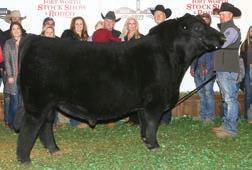
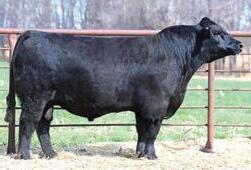

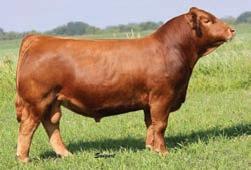
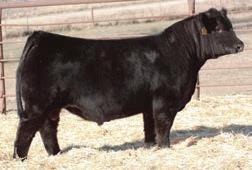








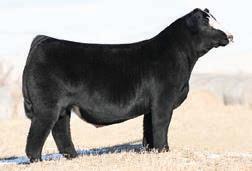









































SSC Shell Shocked 44B By Remington Secret Weapon 185 EPD: CE: 18 $API: 137 $TI: 73 W/C Fort Knox 609F By W/C Bankroll 811D EPD: CE: 11 $API: 136 $TI: 86 Rocking P Private Stock H010 By WLE Copacetic E02 EPD: CE: 13 $API: 139 $TI: 79 JC King of the Road 468H By KBHR High Road E283 EPD: CE: 14 $API: 180 $TI: 96 Ruby NFF Up The Ante 9171G By Ruby`s Currency 7134E EPD: CE: 11 $API: 119 $TI: 68 W/C Night Watch 84E By CCR Anchor 9071B EPD: CE: 18 $API: 145 $TI: 83 THSF Lover Boy B33 By HTP/SVF Duracell T52 EPD: CE: 13 $API: 149 $TI: 91 W/C Pinnacle E80 By W/C Loaded Up 1119Y EPD: CE: 14 $API: 119 $TI: 71 ACLL Fortune 393D By MR TR Hammer 308A ET EPD: CE: 9 $API: 119 $TI: 68 Mr SR 71 Right Now E1538 By Hook`s Bozeman 8B EPD: CE: 15 $API: 156 $TI: 96 HOF New Era 1882J By CLRS Guardian EPD: CE: 15 $API: 196 $TI: 106 Reckoning 711F By W/C Relentless 32C EPD: CE: 9 $API: 111 $TI: 63 TJSC King of Diamonds 165E By LLSF Pays To Believe ZU194 EPD: CE: 13 $API: 114 $TI: 70 PBF Red Paint F88 By W/C Executive Order 8543B EPD: CE: 12 $API: 124 $TI: 75 SC Pay the Price C11 By CNS Pays to Dream T759 EPD: CE: 7 $API: 114 $TI: 79 Next Level 4014J By Dakota Outlaw G974 EPD: CE: 10 $API: 115 $TI: 78 W/C Double Down 5014E By W/C Executive Order 8543B EPD: CE: 14 $API: 119 $TI: 74 JASS On The Mark 69D By W/C Loaded Up 1119Y EPD: CE: 11 $API: 102 $TI: 68 W/C Relentless 32C By Yardley Utah Y361 EPD: CE: 10 $API: 118 $TI: 74 WLE Copacetic E02 By HPF Quantum Leap Z952 EPD: CE: 14 $API: 109 $TI: 80 Holtkamp Clac Change Is Coming 7H By WLE Copacetic E02 EPD: CE: 14 $API: 108 $TI: 75 W/C Cyclone 385H By W/C Bankroll 811D EPD: CE: 12 $API: 138 $TI: 82 LLSF Vantage Point F398 By CCR Anchor 9071B EPD: CE: 14 $API: 122 $TI: 86 PAL/CLAC Meant To Be 823E By Mr HOC Broker EPD: CE: 11 $API: 111 $TI: 68 3/4 SimAngusTM EPD as of 7/31/23 Full brother to W/C Bankroll NEW NEW NEW NEW NEW 3/4 NAILE and NWSS Champ 3/4 SimAngus NEW NEW NEW NEW NEW NEW NEW NEW NEW NEW 3/4 SimAngus NEW NEW

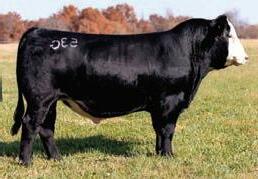




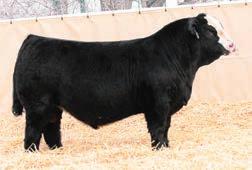
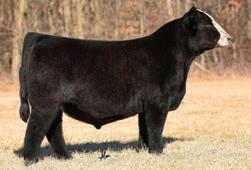

















































KSU Bald Eagle 53G By Hook`s Eagle 6E EPD: CE: 15 $API: 186 $TI: 102 WS Revival B26 By LLSF Uprising Z925 EPD: CE: 9 $API: 103 $TI: 68 CLRS Guardian 317G By Hook`s Beacon 56B EPD: CCE: 16 $API: 208 $TI: 115 FELT Perseverance 302F By W/C Executive Order 8543B EPD: CE: 16 $API: 120 $TI: 73 W/C Express Lane 29G By Rubys Turnpike 771E EPD: CE: 14 $API: 142 $TI: 87 LLSF DAUNTLESS K07 By HPF/HILL Uprising C104 EPD: CE: 13 $API: 111 $TI: 67 WLE Black Mamba G203 By WLE Copacetic E02 EPD: CE: 14 $API: 136 $TI: 84 LLSF Pays To Believe ZU194 By CNS Pays To Dream T759 EPD: CE: 9 $API: 121 $TI: 78 CLRWTR Clear Advantage H4G By LLSF Vantage Point F398 EPD: CE: 16 $API: 172 $TI: 105 LLW Card Merit 03H By TL Ledger EPD: CE: 9 $API: 112 $TI: 72 TL Ledger 106D By Profit EPD: CE: 10 $API: 116 $TI: 70 OBCC Kavanaugh F236 By OBCC Unfinished Business EPD: CE: 13 $API: 141 $TI: 81 GCC New California 131J By GEFF County O EPD: CE: 3 $API: 101 $TI: 65 LLSF Favored One H98 By LCDR Favor EPD: CE: 7 $API: 130 $TI: 96 Wheatland 3-D 1142J By CKCC LD Dimension 8965 EPD: CE: 8 $API: 121 $TI: 75 Semen available on the best Angus and Clubbie sires too. WHF/JS/CCS Double Up G365 By W/C Double Down EPD: CE: 11 $API: 111 $TI: 73 LCDR Favor 149F By LCDR Witness 541C EPD: CE: 7 $API: 130 $TI: 96 Erixon Bitten 203A By NCB Cobra 47Y EPD: CE: 12 $API: 148 $TI: 87 TJ 50K 485H By TJ Teardrop EPD: CE: 11 $API: 159 $TI: 86 W/C Style 69E By Style 9303 EPD: CE: 17 $API: 135 $TI: 68 www.cattlevisions.com Call for your free book Entire lineup online at: 573-641-5270 Mr Ishee Triple Trailblazer 018H By KOCH Big Timber 685D EPD: CE: 14 $API: 144 $TI: 80 HRCC Hondo 035 By W/C Bankroll EPD: CE: 12 $API: 113 $TI: 77 CDI Innovator 325D By TJ Main Event 503B EPD: CE: 12 $API: 132 $TI: 92 EPD as of 7/31/23 NEW NEW NEW NEW NEW NEW NEW NEW NEW NEW NEW NEW NEW NEW NEW NEW NEW NEW NEW
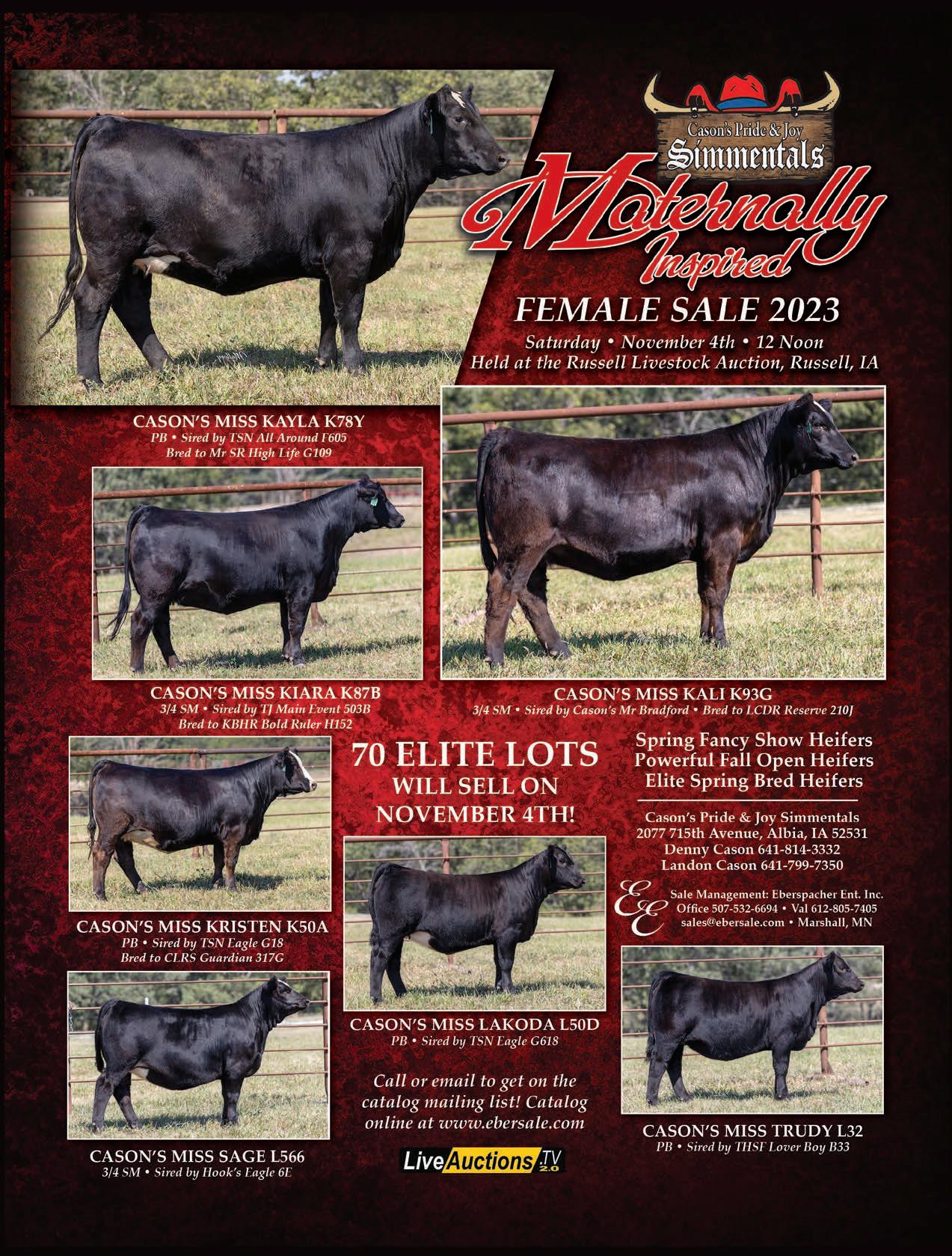



 by Callie Cooley, ASA communications coordinator
by Callie Cooley, ASA communications coordinator



 by Wyatt Bechtel, Filament Ag
by Wyatt Bechtel, Filament Ag
































 by Chip Kemp, director, ASA and IGS Commercial and Industry Operations
by Chip Kemp, director, ASA and IGS Commercial and Industry Operations







































 by Dr. Robert Hough
by Dr. Robert Hough










 by Callie Cooley, communications coordinator
by Callie Cooley, communications coordinator








 L to R: ASA EVP Dr. Wade Shafer conversing with Fall Focus attendees. The Colorado Simmental Association and Colorado Cattlemen’s Association hosted a day focused on the state’s beef industry, capping the day with a tri-tip dinner.
ASA’s Dr. Jackie Atkins kicked off the educational symposium.
L to R: ASA EVP Dr. Wade Shafer conversing with Fall Focus attendees. The Colorado Simmental Association and Colorado Cattlemen’s Association hosted a day focused on the state’s beef industry, capping the day with a tri-tip dinner.
ASA’s Dr. Jackie Atkins kicked off the educational symposium.
















 by Sarah Goss, participant
by Sarah Goss, participant












 by Larry H. Maxey, founder and superintendent, NAILE Fullblood Simmental Shows larryhmaxey@gmail.com
by Larry H. Maxey, founder and superintendent, NAILE Fullblood Simmental Shows larryhmaxey@gmail.com




















 by Drovers
by Drovers
















































































































































































